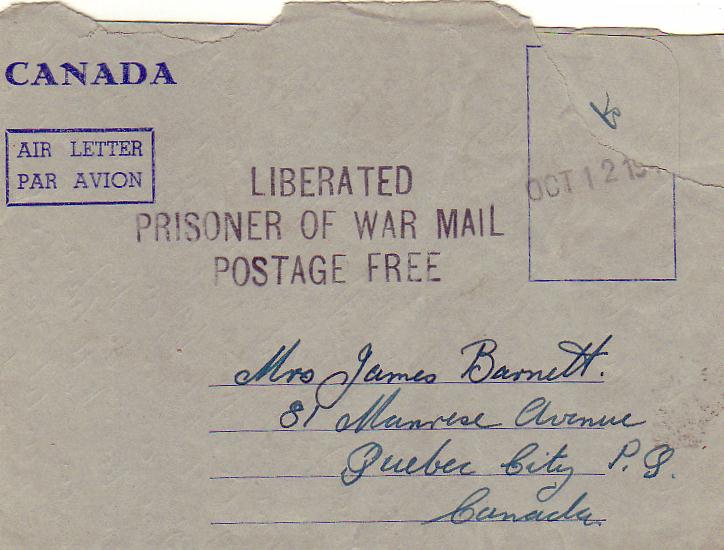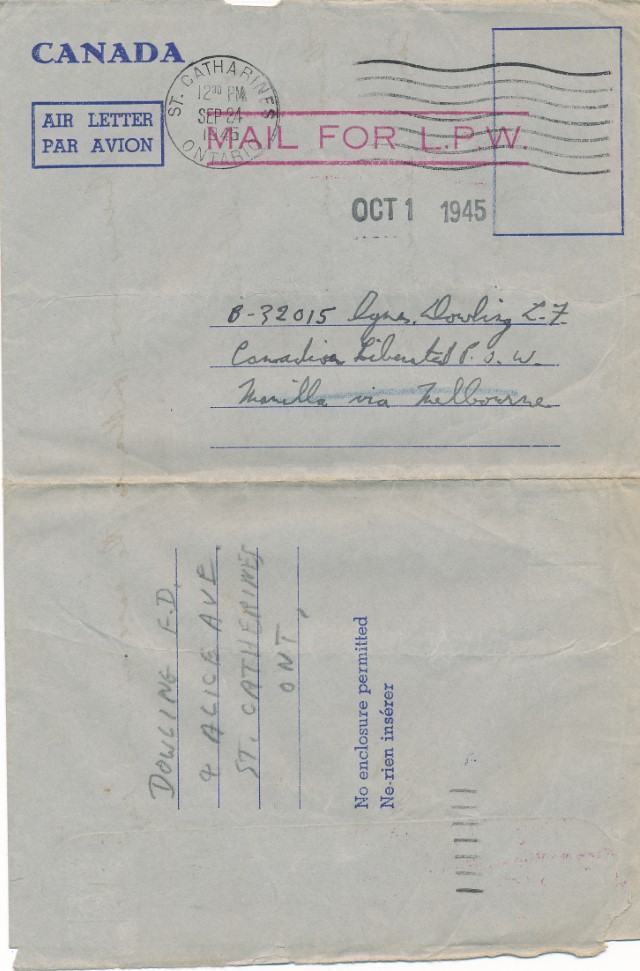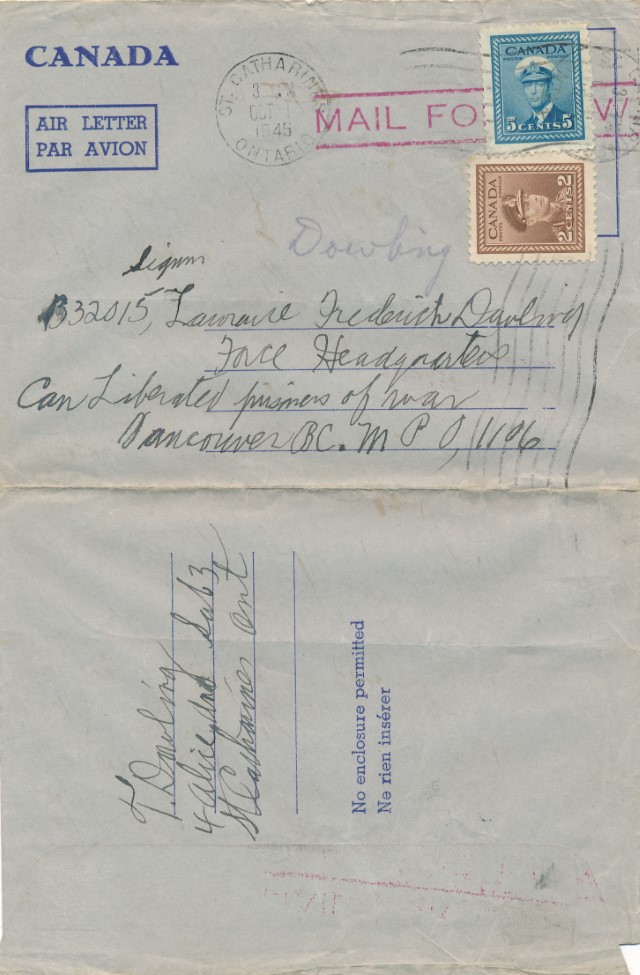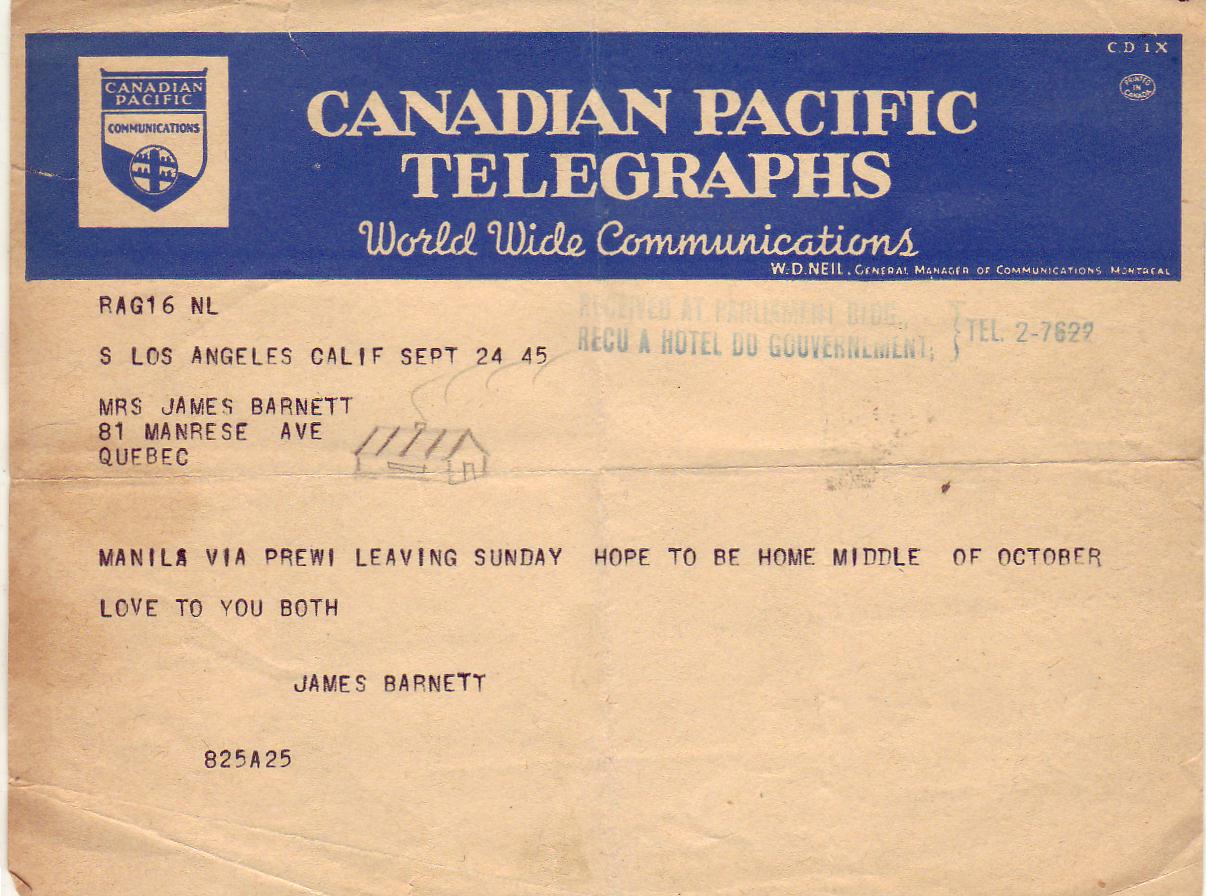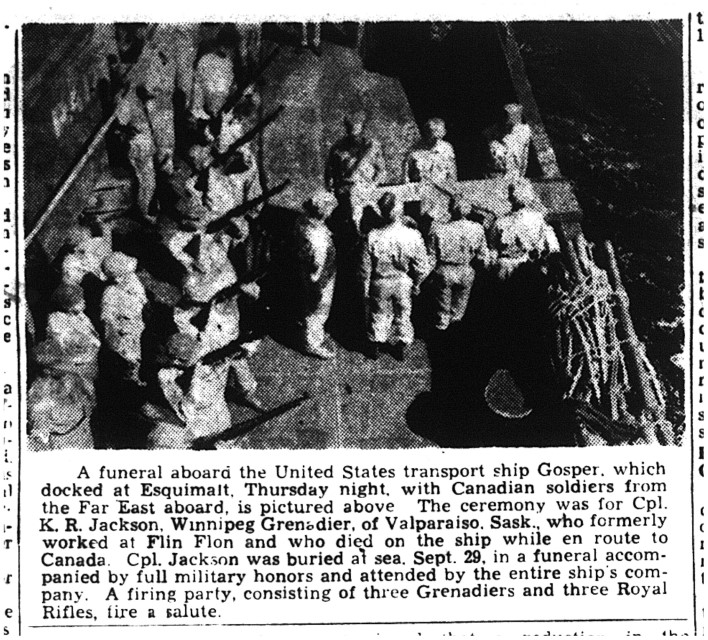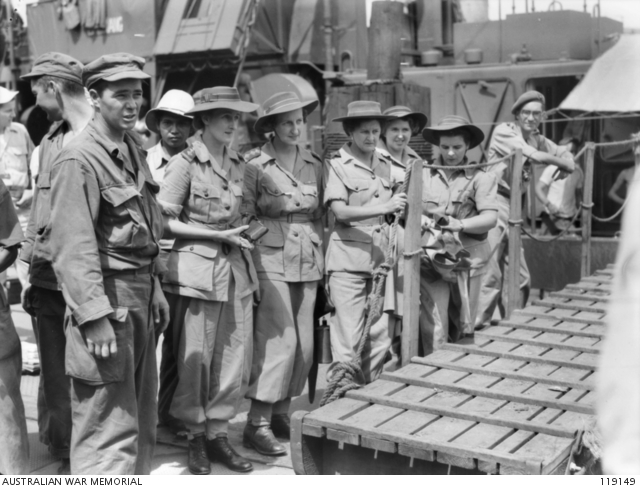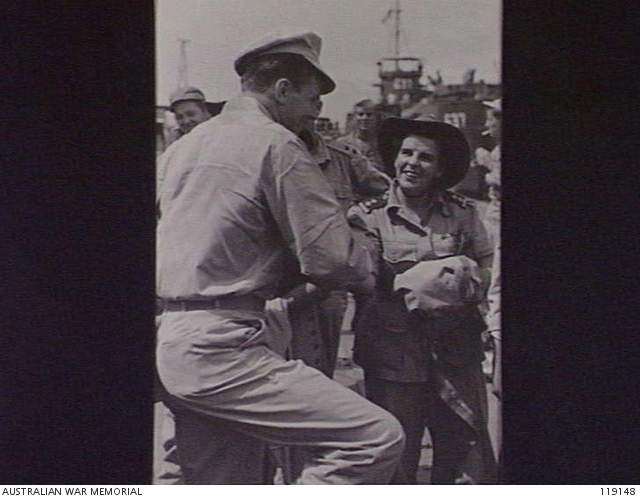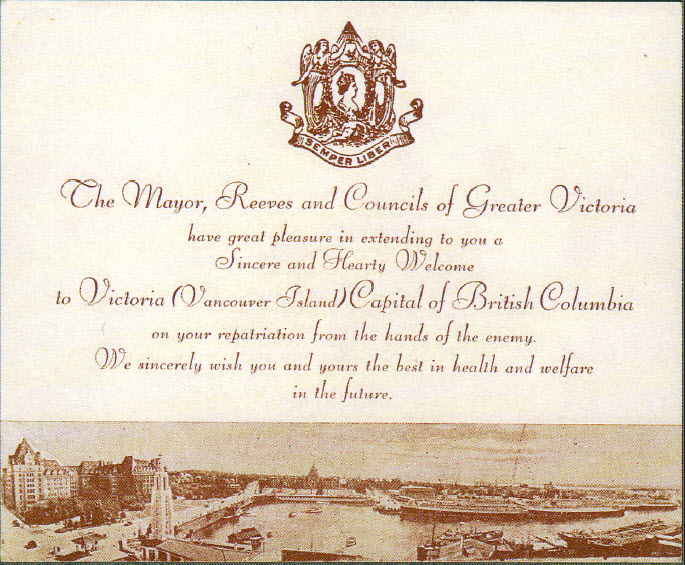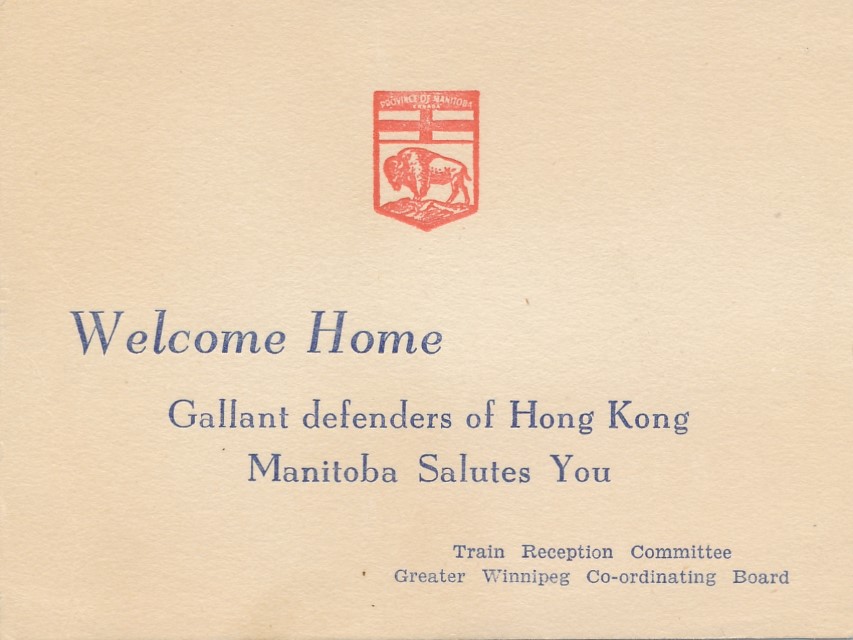(Article originally published in the PHSC Journal. Converted to HTML and reproduced here by permission) Revised: February 19, 2019. Any errors found should be attributed to the conversion process.
On most monitors photos can be viewed in a larger format by selecting them.
Original submission in PDF format is available.
More photos collected by Gene, dealing with this subject are available for viewing in our Gallery.
On the day after the second atomic bomb was dropped at Nagasaki, Japan on August 9, 1945, Japan agreed to the Potsdam Conference terms of unconditional surrender. On August 15, the Japanese Emperor Hirohito broadcast to the Japanese people the news of Japan’s surrender, with the end of hostilities and formal surrender ceremonies to take place on September 2 in Tokyo Bay aboard the American battleship USS Missouri. Many Canadians were prisoners of war (POWs) in Japanese camps when the war ended. There is no full report of how they were rescued and returned to Canada. Nor is there a comprehensive description of the mail services to and from these liberated prisoners of war (LPOWs). This article chronologically tells the story of liberation of the Canadian POWs in Asia and the role of Manila, Philippine Islands in this process.

Figure 1. Front page of the August 15, 1945 issue of the Winnipeg Free Press. (Click for larger image view)
The front page of the August 15, 1945 issue of the Winnipeg Free Press says it all, (Fig. 1). Winnipeg was the home of the Winnipeg Grenadiers, whose survivors were taken Prisoner of War at Hong Kong. Note the Winnipeg Grenadiers crest on the top left of the newspaper page. On page 11 of this issue, the Free Press published the following:
Canadian Prisoners May Go to Manila
Manila, Aug. 15 (CP Cable) - There is a chance that many and possibly all the surviving Canadian prisoners of war in Japanese hands—captives since the fall of Hong Kong on Christmas Day 1941—will be brought to Manila upon their liberation…”
With the conditions of the surrender accepted, American war planes began flying over Japanese and former Japanese territories looking for POW camps. When these camps were sighted, locations were noted and food, clothing and medicines were parachuted to the POWs. A leaflet (Fig. 2) was dropped from the war planes. It informed the former allied POWs that the war was over and that arrangements for their freedom were being prepared. The leaflet was printed on two sides, one in English and the other in Japanese. The leaflet illustrated was dropped on the Sham Shui Po POW camp in Hong Kong and was retained by Signalman Larry Dowling, Royal Canadian Corps of Signals, who was imprisoned there. Note the date and time: Aug. 18, 1945 (4.00 PM).
On August 16, 1945 the Canadian High Commissioner in Canberra, Australia sent a coded message to Ottawa informing them of the sailing on August 15 for Hong Kong of HMCS Prince Robert, with supplies for the Canadian prisoners. Fig. 3 shows a copy of the decoded message.
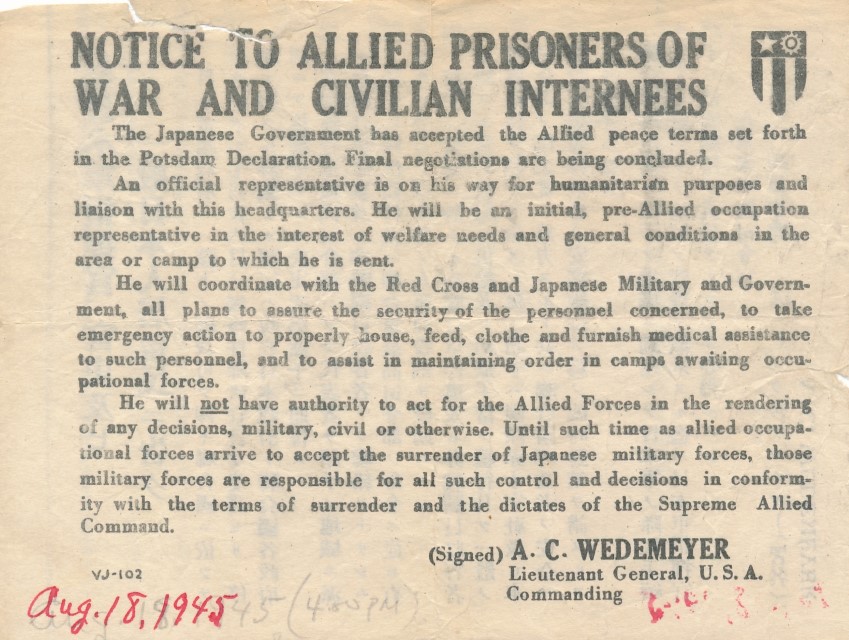

Figure 2. Leaflet informing allied POWs about the Japanese surrender and that representatives were being dispatched as quickly as possible to the camp sites. – Larry Dowling correspondence, courtesy of Sam Chiu. Front page of the August 15, 1945 issue of the Winnipeg Free Press. (Click for larger image view)
Fig. 4 is a photo taken on board the Prince Robert showing extra rum rations being given out during Victory-over-fapan celebrations, on August 16, 1945, while on the way to Hong Kong.
With the surrender of Japan on August 15, the priorities were freeing and tending to the needs of the former POWs such as for medical and health issues, communicating with their families, clothing and feeding, and ultimately the process of bringing them home. Of those Canadians who surrendered at Hong Kong on December 25, 1941, approximately 900 were kept in Hong Kong camps while the balance of about 750 were taken to work camps in Japan. The liberated Canadians in Japan came home via three different routes depending on each individual's circumstances: 1) those with lung trouble, seriously ill and unable to fly were taken by hospital ships to the hospitals on Guam and then sailed to San Francisco, where they were placed on special medical rail cars to be transported to British Columbia; 2) those requiring a few weeks of special feeding and care prior to travelling were sent to hospitals in Guam and then either flown or sailed to San Francisco and then travelled by train to British Columbia; 3) all others were transported by ship or air to the main reception camp at Manila for processing, There, they underwent medical check ups and travelled by ship either to Canada, or to San Francisco and then by rail to British Columbia. All the liberated Canadians in Hong Kong were sent to the reception camp at Manila.
On August 30, 1945, the British Pacific Fleet, comprised of British, Canadian and Australian ships sailed into Hong Kong Harbour, The HMCS Prince Robert was the fifth of the 12 ships to enter Hong Kong.2 The “Robert” was the escort ship of the convoy that took the Canadians to Hong Kong and was easily recognized by the freed Canadians, who began running to the dock to the newly tied up ship. There they were allowed on board and could remain all day. They were fed, received clothing and medical care, and enjoyed the thrill of being free. At night they had to return to the camp site, but were allowed to return to the ship the following day. Figures 5, 6 and 7 show photos of the liberated Canadian prisoners at Hong Kong.

Figure 5: Canadian and British POWs awaiting liberation by the landing party from the Prince Robert, ca. August 30, 1945. – Photo credit, PO Jack Hawes, Canada Department of National Defence – Library and Archives Canada, PA-1148121
The following account of a press conference held by Prime Minister Mackenzie King on August 15, 1945, as reported by The Ottawa Evening Citizen:
Hong Kong Boys Coming Home
The Hong Kong boys are coming home first. That’s the news from Prime Minister Mackenzie King himself.
“They’re free now” he exclaimed.
Talking to a hastily summoned press conference last night, Mr. King said:
“The thoughts of all of us turn toward the boys of Hong Kong.
“Every effort will be made to bring them home at the earliest possible moment.
“They’re all free now; it is just a matter of getting them home.”
Asked how he knew they were free, Mr. King answered:
“It is part of the Potsdam Declaration; the Japanese have agreed to it, and we’ll have them back just as quickly as we can.”
The surrender terms provided for the intermediate freeing of Canadians who were held prisoner by the Japanese. These men, the bulk of them troops captured by the enemy at Hong Kong, would be brought home as “quickly as possible.”
Hong Kong was officially handed over by the Japanese Imperial Army to the Royal Navy on August 30, 1945 with the final surrender taking place on September 16, 1945.
One of the many priorities for the freed LPOWs was to establish a postal communication network for these ex-prisoners to communicate with their families. Fig. 8 shows the front and back of a September 3, 1945 cover written to his son in St. Catharines, Ontario by Rifleman Percy Wilmot of the Royal Rifles of Canada, while he was at Sham Shui Po Camp.
Since there were no general postal services, the postmark on the cover is a home made rectangular chamfered corner postmark that reads: “HONG KONG / 1945 / POSTAGE PAID”, as shown in Fig. 9.
The contents of the letter enclosed in the envelope read as follows:
3/9/45
Dear Stanley:
Well Son here I am a free man again. It is still very hard to realize as yet. It gives one quite a shock to see the husky sailors and soldiers in camp again after looking at skin and bones walking or staggering around for three years and nine months. I am still in hospital but don’t worry about me as I will soon be O.K. when I get some of “Mothers” good cooking into me, tell her I can eat anything now. I have eaten Shark, whale, octopus, seaweed, buffalo and weeds of all kinds, but of course we only got the above mentioned luxuries very, very rarely. Our diet mostly consisted of Rice and Greens, mostly water and sugar. I have lots to tell you when I see you.
Now how have you and “Mother” been Keepin. I do hope and pray you are both well, tell her to look after herself and also look after yourself as well. I have written “Mother” two letters since we were made free, I hope she gets them. Tell “Ede” Auntie Maude, Aunt Lisse and “Florence”, I received their letters and am writing to [unreadable] to Uncle Ernie. The relieving force consisted of “British” “Canadian” and “Australian” forces. One of the ships was the “Canadian” ship “Robert” which was our escort ship when we came out here. We are hoping to leave today on the “Empress of Australia”, we do not know where we are going but we hope it is back to dear old “Canada”. But some say it is Australia. Anyway our forwarding address is, name Number Regt: Liberated Prisoner of War, c/o Australian Army Post Office, Melbourne, Victoria, Australia…
The back of the cover has the same return address as stated in the letter and at this time the LPOWs were unaware that their new home for the next few weeks would be Manila, Philippines. The Canadian repatriation team had not arrived as yet in the Far East, so the mail services were handled by the Australians until the Canadians arrived. [Ed note: this address was also used by British families to send their mail and telegrams to the British LPOWs in Manila.]
The first flight to leave Hong Kong with LPOW mail was on September 4, 1945.3 The mail was carried by the RAFTC (Royal Air Force Transport Command). These flights went to Manila, then to Melbourne and Sydney, Australia and then on to Montreal (Dorval) via Hawaii, see fig. 11. Fig. 8 would have been in the first flight of the RAFTC from Hong Kong. On September 8, postage stamps were made available and civilian mail had to be stamped; LPOW mail could go postage-free as long as it was properly endorsed. All these flights were performed by the RAFTC.
On August 26, 1945, Mackenzie King made public a message that was sent to General MacArthur in Manila to be relayed to the liberated Canadians. The message was as follows:
On behalf of the government and of all the people of Canada I extend to every one of you our deeply heartfelt greetings upon your regaining your freedom. We are rejoicing with you that the day is so near at hand when we shall welcome you home. Your friends and loved ones are counting the hours till your safe return.
Our hearts are filled with unbounded admiration and gratitude for the part you have all played in the defence of the world’s liberties. All of you, members of Canada’s armed forces, and civilians alike, have suffered greatly in the service of your country and the cause of freedom. You have been forced to endure untold hardships, indignities, and in some cases barbarous cruelties. We have known of your sufferings and in thought have shared them with you. The knowledge of what you were being called upon to endure increased our determination to spare no effort which might contribute, at the earliest hour possible, to final victory.
It has been a long and terrible ordeal for you all. But the end has come. Your long period of distress is over at least. All Canada now impatiently awaits your safe return to your homeland. Every possible measure is being taken to ensure your early repatriation and the restoration in fullest measure of your health, strength and peace of heart and mind. You cannot return too soon.
Canadian LPOWs began arriving in Manila from Japan on board British and American war ships and US military air flights. Those coming from Hong Kong arrived in British war ships as well as in the Canadian war ship HMCS Prince Robert and the troop transport HMAT Empress of Australia. All Canadian LPOWs from Hong Kong were brought to Manila as were many from the Japanese POW camps.
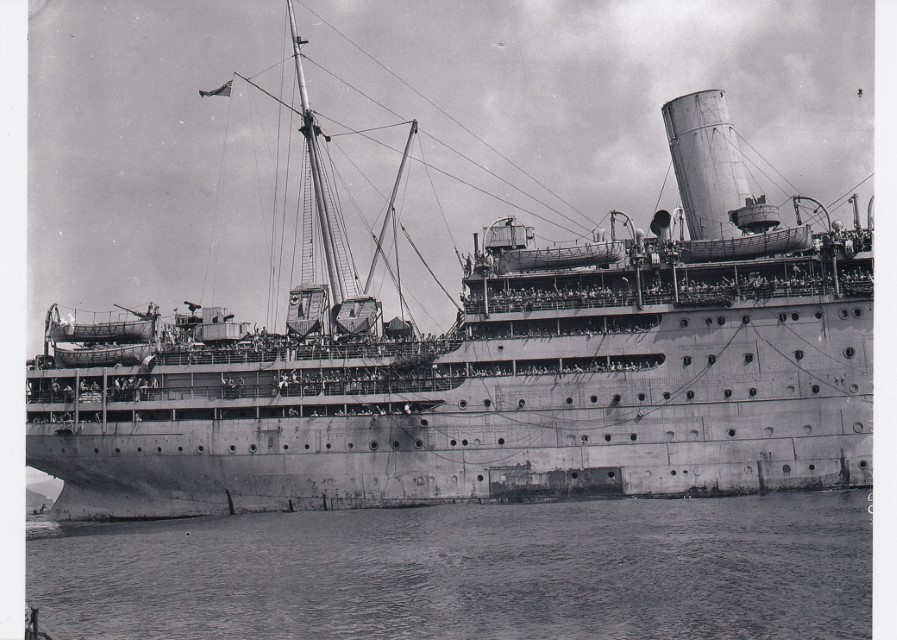
Figure 10: Photo of HMAT Empress of Australia in Hong Kong Harbour with LPOWs and recently released civilian internees on board as she is preparing to leave for Manila. – CWM 19770323-007 George Metcalf Archival Collection, Canada War Museum.
Fig. 10 shows a photo of HMAT Empress of Australia in Hong Kong Harbour with LPOWs and recently released civilian internees from Hong Kong and China as she was preparing to leave for Manila.
3rd Australian Reception Group
With the surrender of Japan, the Australian military began asking for volunteers (Operation Blacklist)4 to assist in the repatriation of the British and British Commonwealth LPOWs. Those who volunteered were assigned to one of the three reception centres where the LPOWs were taken. These assignments were the 1st Australian Reception Group to Morotai Island, Indonesia, the 2nd Australian Reception Group to Singapore and the 3rd Australian Reception Group to Manila. The administration at Manila was made up mainly of the Australian Army with a small contingent of 250 soldiers from the British Army and 32 soldiers from the Indian Army. The Australian military was responsible for operating the camps as well as looking after the repatriation documentation and logistics for the British and Commonwealth personnel.
A newspaper article in The Hamilton Spectator, August 21, 19455 reads as follows:
PLAN TO HANDLE WAR PRISONERS
To Provide Supplies for 1,000 Canadians
Manila, Aug. 21. - (CP Cable) - Tomas Tehan assistant commissioner of the Australian Red Cross, and Lieut.-Col. H. Hern, Australian Comforts Fund commissioner, are organizing a reception group to care for recovered British, Australian, Indian and Canadian prisoners of war.
They expect to provide for some 8,000 Australians, 14,000 Britons and 1,000 Canadians.
Necessary supplies have been ordered and are expected here by air within ten days. Emergency supplies will be rushed where required…
The Australian Army provided postal services for the Australian, British and British Commonwealth LPOWs. When the Canadian military repatriation team arrived, they handled postal services for their LPOWs.

Figure 11: Map showing the route by which the RAFTC flew mail to Canada from Manila. – Courtesy of Robert Toombs
The movement of mail from the Far East POW camps to their destination followed several routes, depending on the origin. The British route was operated by the RAFTC Group No. 300 from Dorval to Sydney, Australia, and then to Manila, with extensions to Hong Kong and back from Manila.6 Fig. 11 is a map showing the route between Manila and Montreal.
The American routes were made up of the Naval Air Transport Service (NATS) Command and the Air Transport Command (ATC),7Both these services operated from San Francisco across the Pacific to Hawaii, Australia, and eventually Manila, Japan and Hong Kong as shown in Fig 12.
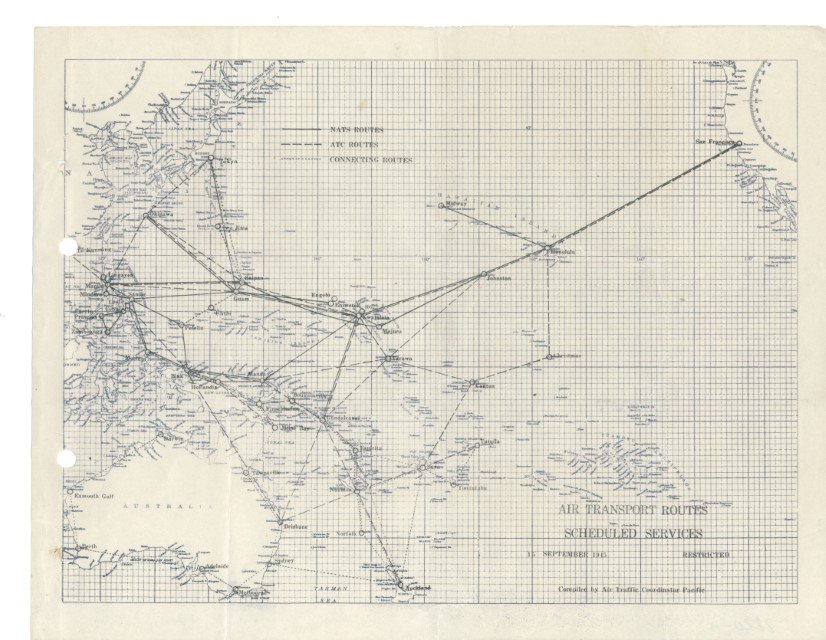
Figure 12: Map showing the route the NATS and ATC flew to Canada from Manila. – Courtesy Robert Toombs7
The British and British Commonwealth LPOW mail from Hong Kong that originally was carried by the RAFTC was referred to as “Liberation, resumption of air service”. When the British and British Commonwealth LPOWs began arriving in Manila, their mail to Australia was carried by the RAFTC. Early mail from the Canadians and the British were also carried on this route and continued on to Canada and the United Kingdom. Canadian covers that bear a date stamp of No. 2 Aust. Base P.O. / F traveled this route. Also early mail from Canada to a LPOW in Manila traveled this route if addressed “c/o Australian Army Base P.O. Melbourne”. When things started to get more organized, mail to Canada was also carried by the NATS or the ATC. Routing was determined by scheduling. Some incoming mail to the LPOWs at Manila was carried by the American military routes.

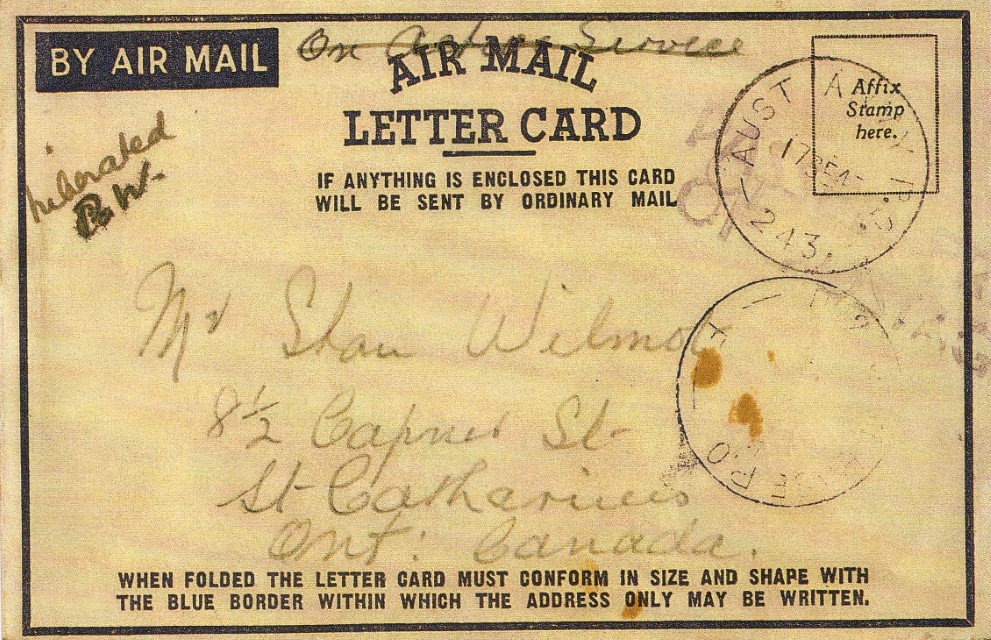
Figure 13: Australian air letter from Manila to Canada. – CWM 20070117-074/14 George Metcalf Archival Collection, Canada War Museum.
The Australian military provided air mail letter cards on board ships as well as at the camp of the 3rd Australian Reception Group. These cards were first issued at Manila on September 12, 1945.8 Fig. 13 shows an Australian air letter card written by Rifleman Percy Wilmot from Manila to Canada with the manuscript “Liberated P.W.”, “On Active Service” crossed out, and postmarked “Aust. Army P.O. / 243 / 17 SE 45, PASSED FREE / OF POSTAGE” and “No. 2 Aust. Base P.O. / F” date stamp, indicating that the RAFTC carried this letter traveled to Canada. The return address on the back is c/o H.Q. 3 Aust P.W. Reception Group Australia.
The contents of the letter are:
313 General Hospital A.P.O. 75
Manilla P.I. Post Office
15/9/45
Dear Stan,
At last I am writing you again as a free man. We have left “Hong Kong” and are now in the “American Army Hospital” in the “Philippines” about 20 miles from Manilla we arrived here last Thursday morning on the “Empress of Australia” & laid out in “Manilla Bay” till evening when we docked and were brought here by “Ambulances”.
I will never forget the sight of the ships in the habour, there were hundreds of them, from aircraft carriers & battleships to transports & large boats.
Well old son I hope you and “Mother” are well take care of yourself and look after her.
I hope to be home soon we may be flown home from here as we get fit to travel.
Do not worry about me as I am getting well looked after here the “Americans” are very good to us here. They simply can’t do enough for us & I shall never forget their kindness. Well old chap I think this is all I can say now. Write if you can “air Mail” hoping to see you soon Love to Mother.”
The Australian Army used two postmarks on Commonwealth mail handled by the 3rd Australian Reception Group in Manila, as are shown with the cover in Fig. 14 which bears examples of both the AUST. ARMY P.O. 241 and 243 date stamps.
The History of the Australian Military Postal Services 1814-1950 by Edward B. Proud9 has no usage dates for 241 in the Philippines. There are sufficient examples on Australian and British covers with 241 post marks to determine that it was used solely by the 3rd Australian Reception Group in Manila. AUST ARMY P.O. / 243 was listed as used from September 1, 1945 to October 20, 1945. Proud also lists post marks 244 and 245 as being sent to Manila on August 19, 1945 and questioned their use. [Ed note: I assume 244 and 245 were used or returned because no examples are known.]
Commonwealth mail from the LPOWs in the Philippines was allowed free of postage as long as it was endorsed “Liberated POW” or “POW” and was on Commonwealth stationery. LPOW mail that was posted using American stationery required prepayment with 6¢ U.S. postage (supplied at no cost to the LPOWs).
After September 9, LPOWs were reaching Manila in large numbers, and by October 17 their recovery was nearly completed; 14,796 LPOWs or internees passed through or were held by the 3rd Australian Reception Group: 11,500 British, 2,650 Australians, 27 New Zealanders, 160 Indians, 123 Burmese, 131 Malays, 48 Chinese, over 1,000 Canadians and 8 Portuguese.
On October 19 the British Repatriation Team took over responsibilities for the administration of the 3rd Australian Reception Group. The Australians were preparing to close their section of the camp and proceed home to Australia.10 On October 24, the 3rd Australian Reception Group had completed its work at Manila and embarked home to for Australia, leaving the British in charge.

Figure 15: Decoded Canadian transmission regarding sending Canadian repatriation officers to Hong Kong and elsewhere. – Library and Archives Canada, RG12, Vol. 1086, File 11-12-41
Canadian Repatriation Liaison Group (CRLG)
As early as August 17, 1945, preparations were made to form a Canadian repatriation team to go to the Far East for the repatriation of the Canadian LPOWs. E. H. Norman, formerly the language officer of the Canadian legation in Tokyo, headed the official repatriation team. Norman himself was repatriated to Canada in August 1942 with other Canadian diplomats.
On August 17, 1945 at Canberra, Australia, The Acting High Commissioner for Canada in Australia, sent a coded transmission to The Secretary of State for External Affairs, Ottawa, figure 15. This transmission reads:
…5. No doubt consideration has been given in Ottawa to sending of Canadian repatriation officers to Hong Kong and elsewhere regardless of whether they go on Canadian ships. Noble says that Royal Navy is arranging to send group of about 50 men of various services by plane to Hong Kong via Manila leaving Sydney August 18th or 19th to look after mainly prisoners of war. A Canadian would be able to go with this group.”
With the end of hostilities, some members of the Canadian Radar Detachment which had been serving in Darwin, Australia along with members of the Canadian Intelligence Corps Personnel (No. 1 Special Wireless Group, Royal Canadian Corps of Signals (RCCS)), were used by the Canadian Military Attaché (Col. Cosgrave) for POW repatriation duties until the arrival in Manila from Canada of the Canadian Repatriation Liaison Group (CRLG) under the command of Lt. Col. M. W. McA’Nulty.11
On August 22, 1945, the St. Catharines Standard carried this story:
Canadian Officials to Manila
CANBERRA, Aug 22 (CP) – Col. L. M. Cosgrave, military attaché of the Canadian high commissioner’s office, left today for Manila to head a Canadian military party charged with locating and repatriating Canadian prisoners of war in Japanese-held territory.
Cosgrave will be assisted by officers and men from Australia as well as Canada. The commissioner’s office said Canadian relief supplies already are en route to the far east.

Figure 16: Article from the Toronto Star giving details of the Canadian repatriation teams proceeding to the 5th Replacement Depot at Manila. Toronto Star, August 23, 1945.
Fig. 16 shows a newspaper article from The Toronto Star, August 23, 1945, "MANILA PREPARES WELCOME FOR 1,000 CANUCK PRISONERS"; this article gives information and details of the 5th Replacement Depot. A Replacement Depot is an area set up by the military in which weapons, supplies and equipment are stored and when needed at the front, they are dispatched from here. There were several Replacement Depots in the Philippines with the 5th being the largest.

Figure 17: Photo of Lieut.-Col. M. W. McA’Nulty and Major Angus Barwick who are in command of the Canadian repatriation team, as they are boarding a plane for their trip to Manila. – St. Catharines Standard, August 25, 1945
On August 22, Lt.-Col. M. W. McA’Nulty and Major Angus Barwick left Ottawa for the west coast, where they caught a flight to the Philippines. The newly formed CRLG team was made up of 15 officers and 15 NCOs, with other members to be arriving shortly. Fig. 17 shows a photo from the St. Catharines Standard, August 25, 194512 issue, Canadians Fly to Manila, with the following caption: Lieut-Col. M. W. McNulty of Sherbrooke, Que., commanding officer, and Major Angus Barwick of Montreal, second in command of a party of 30 officers and men who are flying to Manila as the Canadian repatriation liaison group in connection with the return of Canadian prisoners of war. They are seen boarding their plane at Ottawa.
When the CRLG team left Ottawa to assist members of the Canadian Radar Detachment and No. 1 Wireless Group. the Hamilton Spectator of August 29, 19454 had the following news story about the group:
Officer Leaves For
Manila
Major Brown, This City,
to Help With Prisoners' Return
A Hamilton officer – Major T. J. Brown – it has been announced by Defence Headquarters, Ottawa, is one of a party of four officers and six non-commissioned officers of the Canadian Army who have left by air for Manila to assist in the repatriation of Canadian prisoners of war released from Japanese detention with the end of the war<…
Others in the party flying to Manila, according to the Ottawa announcement, include Major John M. Howlett, Winnipeg; Major A. I. Matgeson, Toronto; Major E. L. Williams, of the Intelligence Corps, Ottawa; R.S.M. D. J. Davies, Carleton Place; Q.M.S. D. Ryan, Ottawa; Q.M.S. W. B. Searle, Nortwood Hills, England; Acting Q.M.S. W. G. Hipson, Kingston, and Acting Q.M.S. F. C. Lowington, Corwhin.
On arrival at Manila they will join Lieut.-Col. W. M. McA'Nulty and Major Angus Barwick, who left Ottawa some days ago for the Pacific theatre.
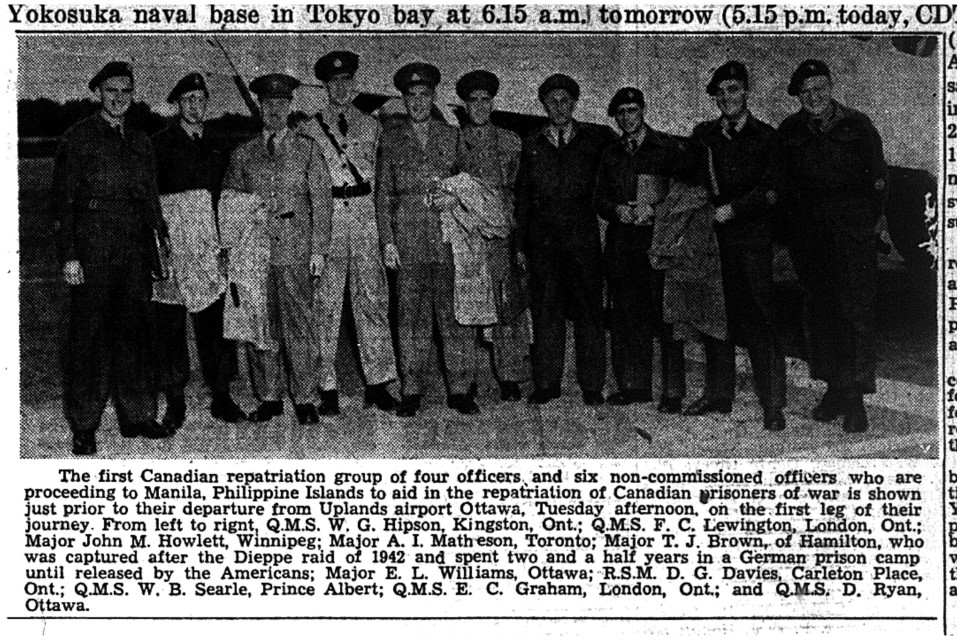
Figure 18: Photo of the four officers and six non-commissioned officers who will be heading to Manila. – Winnipeg Free Press, August 29, 1945
Fig. 18 is from the August 29, 1945 Winnipeg Free Press which shows a photo of this first group departing from Uplands airport in Ottawa prior to leaving for Manila.
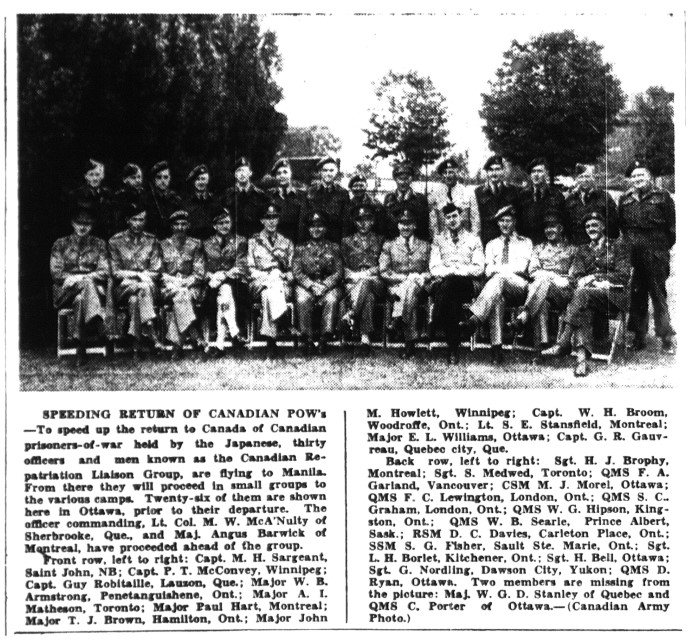
Figure 19: SPEEDING RETURN OF CANADIAN POW’s – To speed up the return to Canada of Canadian prisoners-of-war held by the Japanese, thirty officers and men known as the Canadian Repatriation Liaison Group, are flying to Manila. From there they will proceed in small groups to the various camps. Twenty-six of them are shown here in Ottawa, prior to their departure. – Canadian Army Photo, Ottawa Evening Citizen, Sept. 4, 1945.
Fig. 19 shows a photo of the CRLG prior to their leaving for Manila. There were 30 members of the CRLG of which 26 are shown here, with Lt-Col. M. W. McA’Nulty of Sherbrooke, Quebec and Major Angus Barwick of Montreal, having left a few days earlier. Absent from this picture are Major W. G. D. Stanley of Quebec and QMS C. Porter of Ottawa.
[Note: Captain Terry McConvey, was a Canadian POW who was taken prisoner by the Germans near Caen in the opening days of the Normandy invasion. Sergeant Stephen Medwed of the Canadian Medical Corps was part of the original Canadian repatriation for the Canadians coming home from Europe and quickly volunteered for the Pacific job. Also, a Canadian civilian, Bob Faife, who was deemed a Japanese specialist, joined the team. Faife was interned in Shanghai as a civilian internee from November 1942 to December 1943: he came home aboard the Gripsholm.13]
On August 30, 1945, Lt. Col. M. W. McA’Nulty along with Maj. A, C. Barwick arrived at Manila by air and then proceeded to the 5th Replacement Depot to report to Brig. Winter of the 3rd Australian P.O.W. Reception Group. The balance of the CRLG were unable to obtain transport across the Pacific and proceeded eastward across Europe to Ceylon by air.11 On August 31, personnel of the Canadian Intelligence Corps arrived at the 5th Replacement Depot to join the CRLG.11
Fig. 20 is a photo of Major A. I. Matheson receiving his ticket to the Philippines. Matheson was in charge of the first Canadian repatriation liaison group of four officers and six non-commissioned.
On September 3, another group of the CRLG arrived at Manila from Ottawa taking the eastward journey via Scotland, Palestine, Karachi and Ceylon.11 On September 6, personnel of the Department of External Affairs (Canada) arrived in Manila by air from Canada. Dr. E. H. Norman, Peter Campbell and George Powers joined the CRLG in the recovery of Canadian internees in Japanese hands.11 On September 9, a further 16 members of the CRLG arrived from Ottawa via England, Karachi and Ceylon.11 The last group of the CRLG arrived on September 18 from Ottawa via the U.K., Calcutta, Australia and Morotai.11

Figure 20: Photo of Major A. I. Matheson, receiving his ticket to the Philippines. – Canadian Army Photo, London Free Press, August 30, 1945.
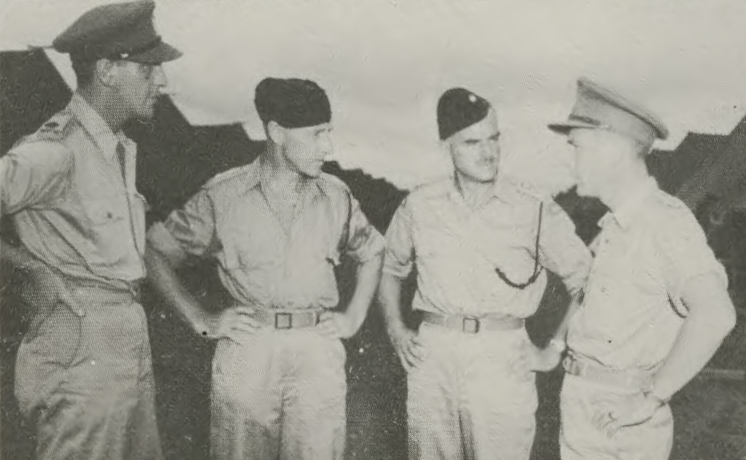
Figure 21: Photo of Major A. I. Matheson (left) and Major T. J. Brown (right). Members of a four-man recovery team talk with Lt. Col. W. J. Home, commanding officer of the interned Canadians and his battalion commander, Maj. G. Trist of the Winnipeg Grenadiers.14
Fig. 21 is a photo of members of a four-man recovery team in Manila who attended to the Canadian prisoners of war in Asia.

Figure 23: November 18, 1945 cover to Ottawa from Major Armstrong of the CRLG. – Photo supplied by Robert Toombs
Fig. 22 shows a cover to Ottawa, Canada from Major W. B. Armstrong of the CRLG dated October 23, 1945 in Manila. Note the use of the U.S. 6¢ air mail envelope postmarked with APO 711 date stamp. APO 711 was assigned to Manila at this time.
Fig. 23 illustrates a second cover to Ottawa from Major W. B. Armstrong, dated APO 711 (November 18) in Manila. Its U.S. 6¢ air mail stamp was canceled by US Navy PO 10499, at Guam. It was mailed on the group’s way home. This cover was from a member of the Canadian Repatriation Team on their home from Manila on board the Canadian hospital ship HMCHS Letitia, which left Manila on November 12, 1945.
With arrangements being made for the Canadian LPOWs by the CRLG The Hamilton Spectator, August 29, 19455 had the following news story:
Canucks Caged In Prison Camps Move Home Soon…
Manila, Sept. 1. - (BUP) - About 1,500 Canadians, liberated from Japanese prison camps in China, should be in Manila or on the way home by the end of September, Lieut.-Col. M. W. McAnulty, commanding the Canadian repatriation group here, told the British United Press to-day…
Each liberated man is to receive $100 on arrival at the camp here and a gift bag containing cigarettes and tobacco, toilet articles, candy, writing equipment and other needed articles. Complete new uniform kits will be issued.
On November 12, the Canadian Repatriation Team along with the members of No. 1 Special Wireless Group, Royal Canadian Corps of Signals (RCCS) left Manila aboard the Royal Canadian Navy hospital ship HMCHS Letitia.15 They arrived at Vancouver on December 6. Fig. 24 is a photo of HMCHS Letitia arriving at Vancouver.
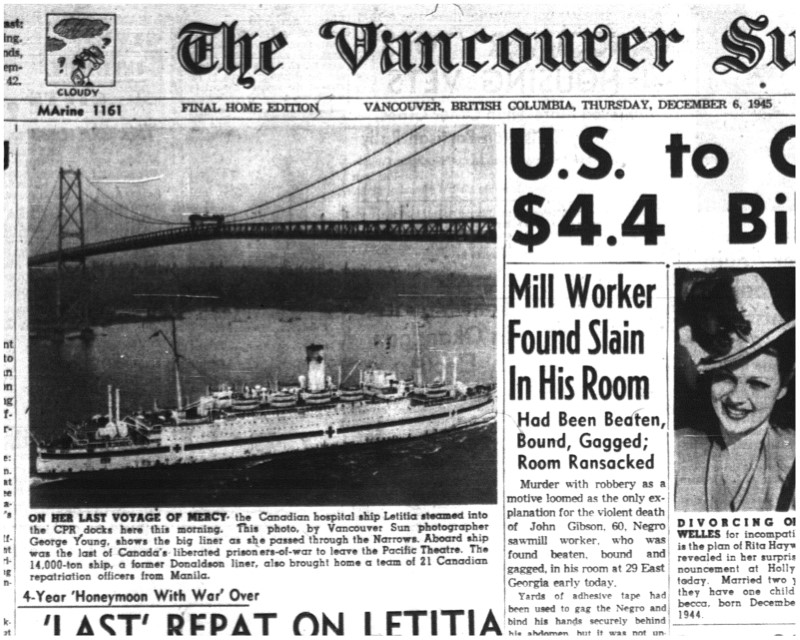
Figure 24: Newspaper photo of the HMCHS Letitia arriving at Vancouver. – Vancouver Sun, December 6, 1945.
5th Replacement Depot
Before the Japanese accepted the Potsdam Declaration, the United States Army began preparations for Replacement Camps to be set up for processing Liberated POWs and civilians internees who had been held by the Japanese. Replacement Command operated under the command of Lt. General W. D. Styer (Commanding General, United States Army Forces Western Pacific). On August 12, Styer assigned Major General F. E. Uhl, (Commanding General, Replacement Command) to oversee the Recovered Personnel Program. On August 21, Uhl, issued a letter to Commanding Officers, Officers, and Enlisted Personnel of the 5th Replacement Depot, 29th Replacement Depot and Women's Replacement and Disposition Centre (see Fig. 25).

Figure 25: Copy of letter from Major General Uhl to the personnel of the Replacement Depots where the Liberated POWs and civilian internees were to be processed on their way home.14
The following article from the August 15, 1945 Melbourne Argus16 briefly describes how liberated internees would be evaluated from Japan:
Release of Internees and POW's, Distress Relief Organised
by James O'Connor, Manila
Full preparations are in hand to alleviate distress among the Allied civilian internees and POW’s upon their liberation from the Japanese home islands following the Japanese surrender.
It is estimated there are some 40,000 persons more than half being British subjects including, Australians, Canadians, New Zealanders, and Indians as well as some 16,000 Americans…
Initially, evacuation plans called for over 70 Allied recovery personnel units to move in along with the occupation forces throughout the liberated territories. The first plane with evacuees should be on its way to Manila within two or three days after the first landings of the occupying forces. At Manila, the evacuees would be sent to replacement depots and hospitals. One of the first jobs of the personnel units would be to notify families of the prisoners about their status, location and health. The hope was that at the replacement depots the liberated prisoners would be placed on planes or ships for their journey home within five days after their arrival at Manila. Due to the large volume of LPOWs arriving in a short time span, this process took between two and three weeks. It is estimated that 30% of the prisoners would need hospital care at Manila. The prisoner recovery units would include American, Australian, British, Canadian, New Zealand, Indian and Dutch repatriation teams.
On August 30, 1945, the British aircraft carrier HMS Speaker entered Tokyo Bay for the surrender ceremonies. The following day, the last of her aircraft and all of her air maintenance personnel were transported to the British carrier HMS Ruler. With the hangar deck vacant of aircraft and air crews, workers erected living quarters, dining, entertainment and medical facilities on the deck. That evening, within five minutes of dropping anchor, landing craft from the USS Gosselin arrived alongside Speaker carrying LPOWs from the Tokyo area who were deemed fit enough to travel. This process was repeated throughout the night. These LPOWs were mostly British servicemen from all three fighting services and the merchant marine. There also were British Commonwealth servicemen including Africans and Indians. By noon on September 1, 54 officers and 423 other ranks had been accommodated.17
At 1300 on September 3, Speaker was the first allied ship to depart Tokyo Bay and set a course for Manila with her cargo of LPOWs. Figures 26 and 27 shows HMS Speaker sailing out of Tokyo Bay. Here is the related newspaper story from the September 4, 1945 Ottawa Evening Citizen:
500 Empire Prisoners of War Start
Voyage Home Aboard Escort Carrier
by Astley Hawkins.
TOKYO BAY, Sept. 3 - (Reuters) … On her way out of the bay, the Speaker, her passengers gathered on the forward end of the flight deck and the crew along the ship’s sides, passed close to the battleships HMS Duke of York and HMS King George V, whose assembled crews cheered the men.
The Speaker, music blaring from the loud speakers, then swung around by the Australian destroyer Bataan, from whose bridge Admiral Sir Bruce Fraser, British Pacific Fleet commander, waved his arms farewell. Admiral Fraser had just returned from conferences with Gen. MacArthur about the evacuation of more British prisoners among the 36,000 Allied men once estimated to be in Japan.
Aboard the Speaker just before she sailed for a port where the men will be sorted out for distribution to their homes in Britain, Australia, Canada and elsewhere…
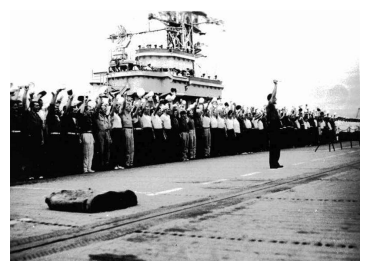
Figure 26: HMS Speaker sailing out of Tokyo Bay with her LPOW passengers waving to other allied ships in the Bay. – Courtesy Royal Navy Research Archives. Photos from the collection of Bernard Stogdem.
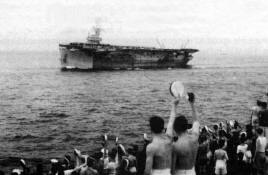
Figure 27: Crew of allied ships waving to HMS Speaker and her passengers as she sails out of Tokyo Bay. – Courtesy Royal Navy Research Archives. Photos from the collection of Bernard Stogdem.
On September 9, HMS Speaker arrived at Manila, where the Australian Army’s 3rd Reception Group was preparing a welcome at the 5th Replacement Depot (approximately 20 miles from Manila). There, the LPOWs received further medical treatment and food, and could write and send telegrams home to their families. Each of the 477 LPOWs on the Speaker were issued five Australian pounds and four American dollars. Fig. 28 shows LPOWs disembarking Speaker onto landing craft at Manila.
After the arrival of the Speaker, ships of the United Kingdom, Australia, Canada, United States, New Zealand and India, as well as US aircraft began ferrying British and British Commonwealth and Dutch LPOWs to Manila. The British and Commonwealth LPOWs from Japan, China, Manchuria, Formosa, Korea and Hong Kong who were healthy enough were transported to Manila, where there was a camp built by the U.S. military capable of holding 4,000 to 5,000 personnel. This camp was separated into sections, with each section catering to its own nationality: Australian, Canadian, British, Indian and New Zealand. Each section also had its own administrative Repatriation Team. The 5th Replacement Depot was often referred to as “The British Empire Camp”. Fig. 29 is a partial view of the camp. Fig. 30 shows the 3rd Australian Prisoner of War Reception Group Headquarters, where the Australian flag is flying.
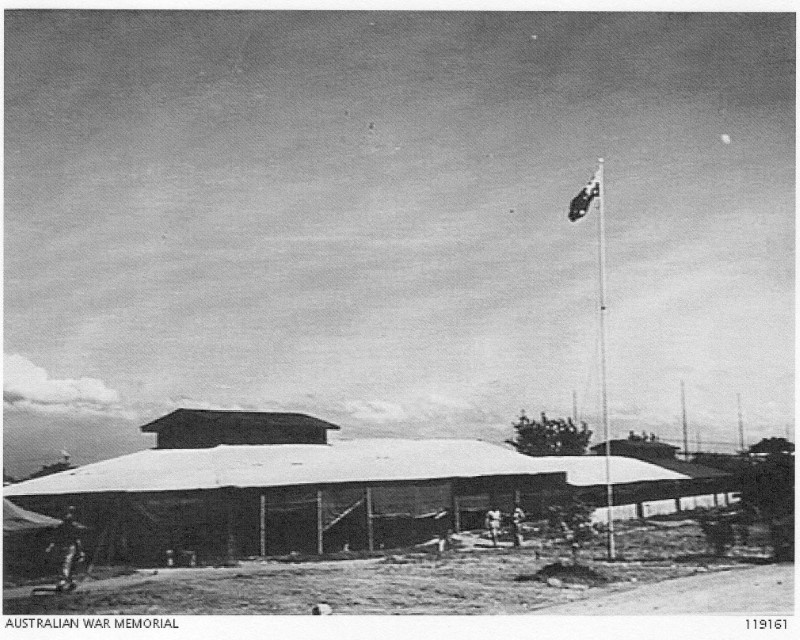
Figure 30: 3rd Australian Prisoner of War Reception Headquarters, with the Australian flag flying outside. – Courtesy Australian War Memorial, Photo 119161. Photograph by Lieutenant N. B. Stuckey.
When the Canadians arrived at the 5th Replacement Depot, the Canadian section of the camp had a truly Canadian atmosphere; freshly-painted street signs bore names of such streets in Canadian cities as Portage Ave., Yonge St., and St. Catherine, Granville and Sparks Sts. The two mess halls were named Fort Garry and Frontenac.
Canadian LPOWs
Here is a brief report from the September 4, 1945 issue of the Globe and Mail:5
Yokohama Sept. 3 by Col. R. S. Malone,
…Prisoners are being moved by various means toward Manila, some by plane and others by ship. Men requiring medical attention are assigned to hospital ships while others are sent to Manila-bound transports.
The September 5, 1945 issue of The Hamilton Spectator5 contained these two articles:
ATTACHE SPEEDS RETURN OF MEN FROM HONG KONG
Hong Kong, Sept. 5. (CP Cable) . . .
…Some on Hospital Ship
Twenty-six Canadians who were liberated in hospital at the time of liberation were taken aboard the hospital ship Oxfordshire which is to sail shortly for Melbourne. Last Sunday morning a second hospital ship, the former New Zealand passenger vessel Mauganui, drew into harbour. . . .
…Land at Manila
New York, Sept. 5. - (AP) - The British hospital ship Oxfordshire, carrying 319 men and women from the Japanese internment camp at Hong Kong arrived at Manila today, a C.B.S. broadcast from the Philippines capital said. All were hospital cases among them 18 amputation cases.
On September 5, 1945, the British hospital ship HMHS Oxfordshire arrived at Manila with the first 319 LPOWs and civilian internees from Hong Kong. Those aboard included British, Canadians, South Africans, Australians, Indians, Norwegians and one American. About 116 were taken from the ship and were transferred to local replacement depots. Fig. 31 shows members of the Winnipeg Grenadiers aboard the Oxfordshire at Manila.

Figure 31: A group of liberated Winnipeg Grenadiers aboard the British hospital ship HMHS Oxfordshire at Manila. Left to right, they are Pte. Duncan Benton, Winnipeg; Pte. Edward Morisseau, Pine Falls; Pte. John St. Onge, St. Boniface; Pte. S. E. Koughnett, Winnipeg; and Pte. J. E. James, Lac du Bonnett. Sitting is Pte. I. Sanderson of West Selkirk. – Canadian Army photo from The Winnipeg Evening Tribune, September 24, 1945
Fig. 32 shows Sgt. R. J. Routledge of the Winnipeg Grenadiers aboard the British hospital ship at Manila. Sgt. Routledge was sentenced by the Japanese to 15 years imprisonment for passing information from his Hong Kong camp to a clandestine British group.
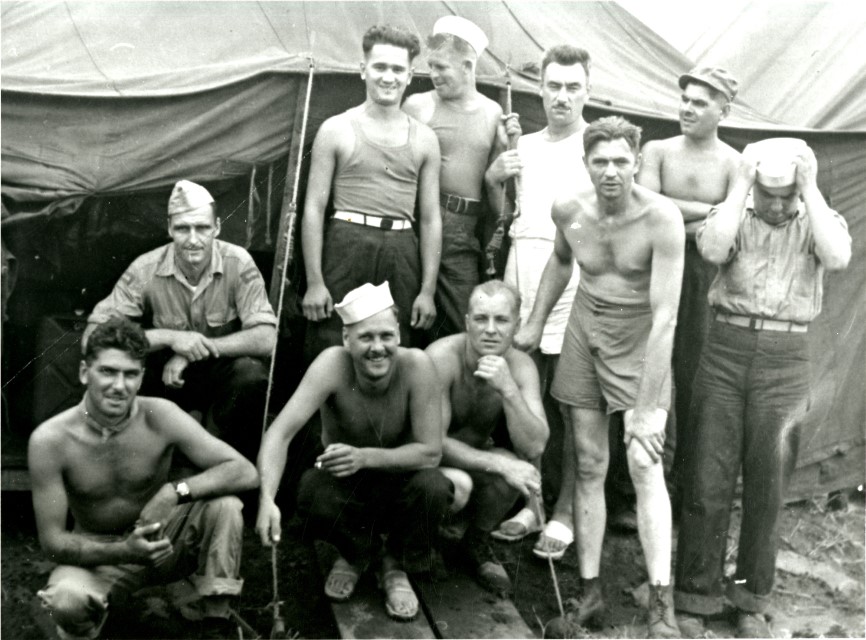
Figure 34: Photo of Canadian liberated POWs outside a tent at the 5th Replacement Depot. – Courtesy of LCMSDS.18
On September 9, the first group of Canadians arrived at Manila from Japan by plane. These Canadians were freed at the port of Yokohama. Those freed at Yokohama who were hospital cases went directly to the United States via Guam. Throughout the day, loaded plane after loaded plane landed at Clark Field and Nicholls Field, at the rate of one every 10 minutes. At the 5th Replacement Depot, the first Canadians entered while American engineers were still working on the facilities. As they got settled, each Canadian was given a 12-page booklet entitled To All Canadian Liberated Prisoners of War and Merchant Seamen in the Far East that was issued by the Inter-Service Committee on Prisoners of War (see Fig. 33). This booklet explains current situations and gives information needed for procedures upon arrival back in Canada. Fig. 34 shows Canadian liberated POWs outside a tent at the 5th Replacement Depot near Manila.18
Here are excerpts from a newspaper article in the September 11, 1945 Niagara Falls Evening Review:19
By WILLIAM STEWART
(Can. Press War Correspondent)
MANILA (CP Cable). For many a Canadian released from Japanese prison camps after being captured at Hong Kong Christmas Day 1941, there’s a job here they’d like – bossing a Japanese working party. One of the first things noted by the prisoners after arriving here yesterday from camps in Japan, where food was slim and work tough, was the healthy-looking Japanese working party which was treated leniently. These Canadians assured their officers they wouldn’t ill-treat or shoot the Japanese but they would make sure the “put in a good day’s work…”
Fig. 35 shows a Japanese work party cleaning up the area after the construction of the facilities for the LPOWs. Note the PW painted on the back of their jackets.
Lt.-Col. W. M. McA’Nulty delivered this message to the men:
We consider it an honour to have been selected to receive you on your release and dispatch you on your way home. Our main purpose is to get you back to Canada to your loved ones and friends just as quickly as humanly possible.
This is a mere staging camp, the first home on your way home. We have tried to organize if for you as a very temporary home. It can and naturally will be a poor substitute but we will provide for you some of the amenities and food of which you so long have been deprived.
An article in the Regina Leader Post, September 10, 1945, reads in part as follows:
First Canadians reach Manila
by COL. R. S. MALONE
Manila, Sept. 10 (CP Cable). The first group of Canadian prisoners liberated from Japanese camps was received Sunday at No. 5 United States replacement depot outside Manila. The Canadian section of the camp now has been organized to handle the majority of liberated Canadians who are not hospital cases.
I watched the first group of men captured at Hong Kong in 1941 climb off trucks to be greeted by Capt. Harold Graham of Owen Sound, Ont., and a sergeant-major. There were no parades, but the men were shown directly to their tents where installation of wooden floors and electric lights was completed just in time Saturday.
On each bed were duffle-bags from the Red Cross for everyone, containing razor, soap, tooth brush, writing materials, clean underwear, towels and other comforts. While some of the men dashed for their first shower baths, others made for the mess hall where a noon meal was awaiting them.
The men were dressed in a weird assortment of clothes given them on shipboard, including blue jeans and American sailors hats. Some had retained remnants of the old Canadian uniforms with which they went to Hong Kong in 1941, the old-style wedge cap and the old-style Canadian haversack. Many carried Japanese rifles as souvenirs…
Waiting for the prisoners was the first batch of air mail letters from their families at home and the first news summary from Canada, wirelessed direct to Manila today.
The Empress of Australia left Hong Kong on September 11 and arrived in Manila on September 13. The headlines in The Toronto Globe and Mail, September 14, 1945,5 stated:
Freed Canadians Arrive at Manila From Hong Kong
Manila. Sept. 13 (CP). The big gray Canadian liner Empress of Australia docked at a battered pier tonight with her 1,815 liberated war prisoners and internees joining a welcoming United States band in Singing “God Save the King” and “O, Canada.”…
Passengers included 337 Canadians captured at Hong Kong in 1941, the last of that nationality there…
…Nine hundred passengers disembarked here, including 150 litter cases. There were four Royal Artillery officers…
The September 14, 1945 issue of the Niagara Falls Evening Review19 contains the following story:
Canadians At Manila
By William Stewart
Canadian Press War Correspondent
MANILA (CP Cable) – The entire group of Canadian prisoners from the Shamshuipo camp at Hong Kong, moved into the reception depot here yesterday where the Canadian flag was raised by Capt. Harold Graham of Toronto, a member of the reception staff.
The group of more than 300 prisoners, headed by Lt.-Col. William J. Home of Quebec, all looked refreshed despite the intensely hot trip to Manila aboard the Empress of Australia. They are in high spirits as they greeted acquaintances who had been in camps in Japan.
A self-contained Canadian area has been established at the depot, which is under American administration, and all Canadian officers and other ranks will remain together until they are processed and set out for home, perhaps in small groups.
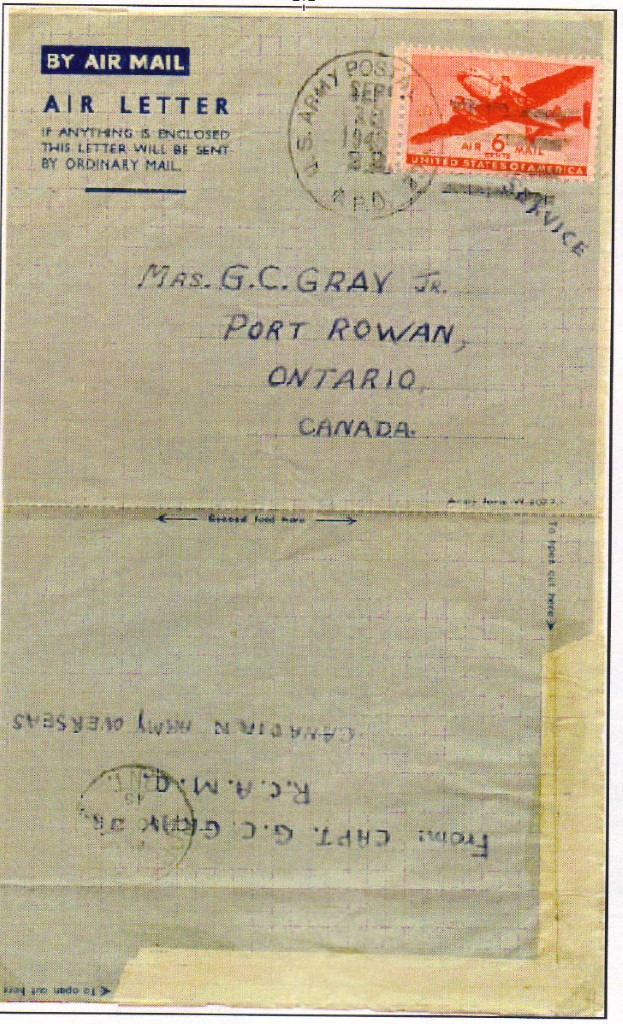
Figure 36: British air letter form written by a Canadian aboard the Empress of Australia. It travelled to North America through the U.S. military postal service. – Courtesy of the Ken Ellison Collection20
British and Australian air letter forms were provided to the LPOWs aboard the Empress of Australia. At Manila, either the U.S. Army or the Australian Army handled the mail from this vessel. Fig. 36 shows a British air letter form written aboard the HMTS Empress of Australia, by a Canadian Captain G. C. Gray Jr. The letter was written on September 12, franked with a 6¢ U.S. air mail stamp, and postmarked U.S. ARMY POSTAL SERVICE / SEP / 18 / 1945 / 22. The 22 refers to 22nd Base Post Office located at Fort McKinley near Manila. The letter reached Port Rowan, Ontario on September 30. The Empress of Australia arrived at Manila on September 13, 1945. This cover was transported by either the ATC or NATS to San Francisco and then by commercial air to Canada. Under the adhesive are the words “ON ACTIVE SERVICE”. If this was handled by the Australians, no postage was needed.

Figure 37: Letter written by a Canadian aboard the Empress of Australia. It travelled east through the U.S. military postal service. Courtesy of Gray Scrimgeour.
Fig. 37 shows an Australian air letter to Canada, written on September 15 aboard the Empress of Australia, also stamped with 6¢ U.S. Air mail postage. It also travelled through the U.S. military postal service to North America. The letter was post marked on September 18 upon its arrival at Manila.
On September 10, 1945, while on board the Empress of Australia awaiting departure, Rifleman Percy Wilmot wrote this British air letter to his wife (Fig. 38). Written on it in pencil is “Liberated U.K. P.W. / On Active Service”. Its postmarks are: the Aust. Army P.O. / 243, 15 SE 45, also “PASSED FREE / OF POSTAGE” in black and the date stamp, No. 2 AUST. BASE P.O. / F, which was used at Melbourne. This routing to Melbourne indicates the letter traveled to Canada by the RAFTC (Ferry Command). The return address on the back is “H.Q. 3 Aust. Pwar Recep Group Aust.”.

Figure 38: Letter written by Percy Wilmot aboard the Empress of Australia and postally handled by the Australian Army. – CWM 20070117-074 George Metcalf Archival Collection, Canada War Museum.
The contents of Wilmot’s letter are as follows:
On Board His Majesty’s Troopship “Empress of Australia”
10/9/45
Dearest Agnes
At last we have left our prison camp and are embarked on board ship.
We came on board yesterday afternoon and this morning we left Victoria and went around to the other side of “Hong Kong” to “Stanley” Fort to pick up the women and children and other internees, we have just had our supper and they are bringing them on now. We are going from here to “Manilla”, where we get off the ship again we do not know where we will go from there, I don’t think it will be Australia…
Fig. 39 shows Canadian LPOWs who had just arrived at Manila displaying a captured Japanese flag.
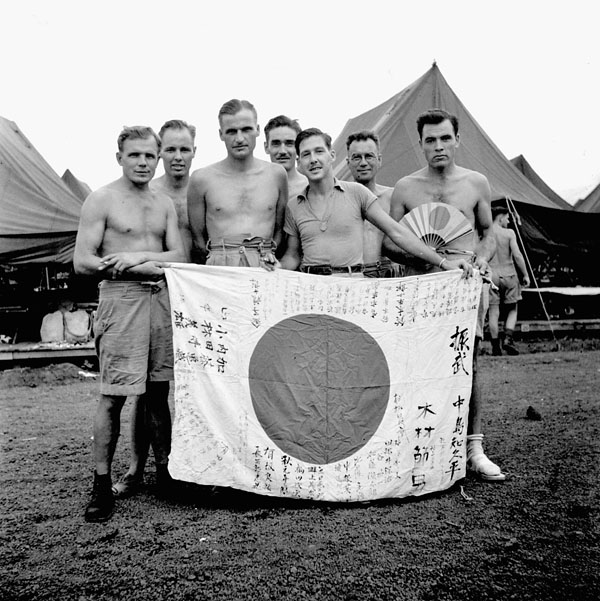
Figure 39: Canadian LPOWs who had just arrived at Manila displaying a captured Japanese flag. – Library and Archives Canada, PA-137745.
According to the September 17, 1945 issue of the Niagara Falls Evening Review,19 a group of Canadians had come from Japan to Manila:
Canadians Escaped
By William Stewart
Canadian Press War Correspondent
MANILA (CP Cable) – Three Canadians have arrived in Manila after a day’s flight and a three-day train ride from a prison camp near Kawasaki, on Japan’s Kyushu Island where, with some 160 other Canadians captured at Hong Kong Christmas Day, 1941, they have been working in coal mines since 1943.
The three, including L. Cpl. John MacPherson of Wolfville, N.S., and two riflemen whose names may not be released until next-of-kin have been notified, arrived as more than 300 liberated Canadians were expected to leave here tomorrow on their homeward journey by sea.
This group excludes 80 hospital cases who will receive medical care until a Canadian hospital ship arrives to pick them up and 32 other Canadians, among the first to reach here from Japanese camps, awaiting air passage to the United States and Canada.
The September 21, 1945 issue of the Niagara Falls Evening Review19 has the following news:
Nearly All Canadians Move Out
By William Stewart
Canadian Press War Correspondent
TOKYO (CP Cable) All but possibly small and isolated groups of Canadian prisoners have been evacuated. Lt-Col. M. W. McAnulty en route to Guam and Manila.
During the last few days the bulk of Canadians liberated in the Japanese home islands have been placed aboard ships and planes and evacuated, Lt-Col. M. W. McAnulty of Sherbooke, Que., head of the Canadian Far Eastern reception group, has returned to Manila to complete the job of speeding the liberated men to their homes in Canada.
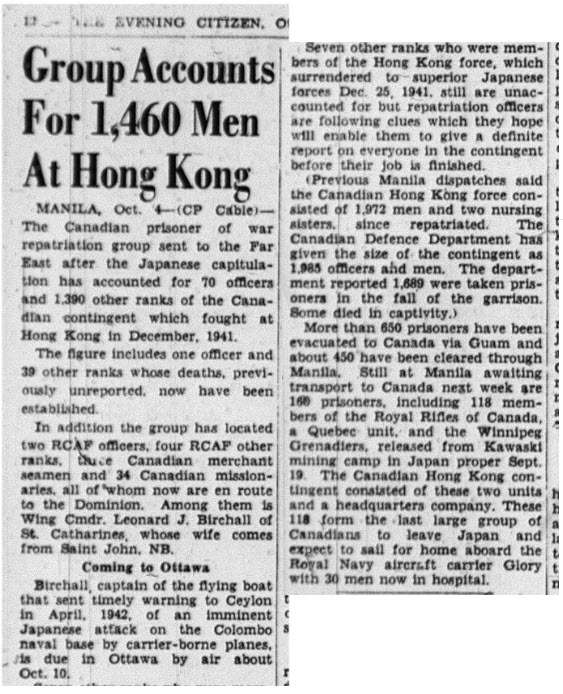
Figure 40: Newspaper article with news from the Canadian repatriation team accounting for the number of LPOWs in Hong Kong and Japan. – The Ottawa Evening Citizen, October 4, 1945.
Fig. 40 shows a newspaper article from the Canadian repatriation team that accounts for the LPOWs liberated from Hong Kong and Japan as well as other Canadians captured by the Japanese.
The Canadian Red Cross made arrangements with the American Red Cross for the transmission of telegrams to the Canadian LPOWs in the Far East, according to this story in the August 17, 1945 issue of the Niagara Falls Evening Review:19
Message Prisoners’
A letter from the Canadian Red Cross Society has been sent to all presidents of branch societies, to the effect that it has been arranged through the Canadian government departments concerned to collect from the next of kin and close relatives in Canada, of prisoners of war and civilian internees in the Far East, short messages to be transmitted to the prisoners and internees upon their liberation and assembly at a reception centre in the Pacific zone.
These messages must be in Washington D.C., by Aug. 25th for transmission through American Red Cross Channels.
Forms are available through the local Red Cross secretaries and all who are interested should apply to local Red Cross secretaries for the forms. Only through these forms can the messages be sent.
Family members of the Canadians could send telegrams through Ottawa when the LPOWs arrived in Manila. The government also sent telegrams when they had information about LPOWs. Fig. 41 shows a telegram informing a family of a liberated POW.
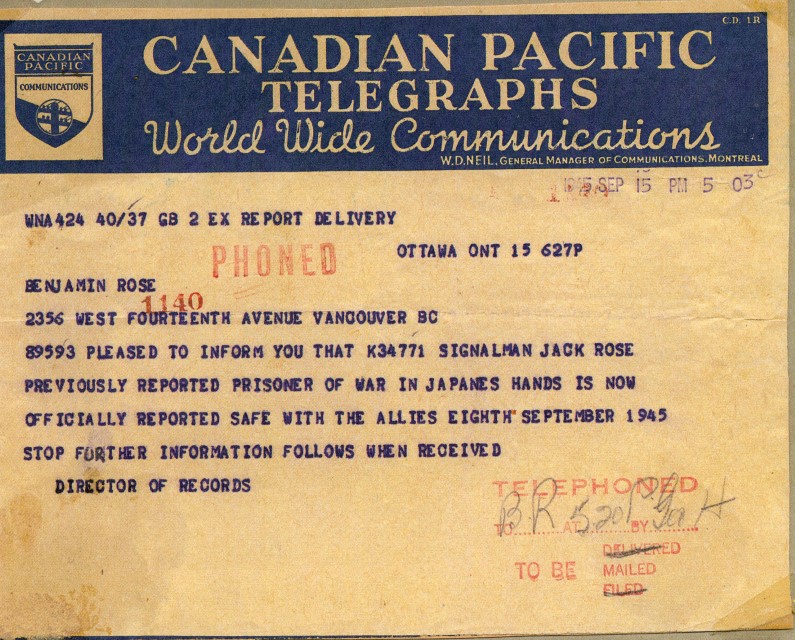
Figure 41: Copy of telegram from Ottawa informing the family of a Canadian that he is now safe in allied hands. – CWM 20120078-005 George Metcalf Archival Collection, Canada War Museum
Fig. 42 shows a telegram from Chaplain Barnett to his wife in Quebec to say that he is well and safe, having arrived in Manila.
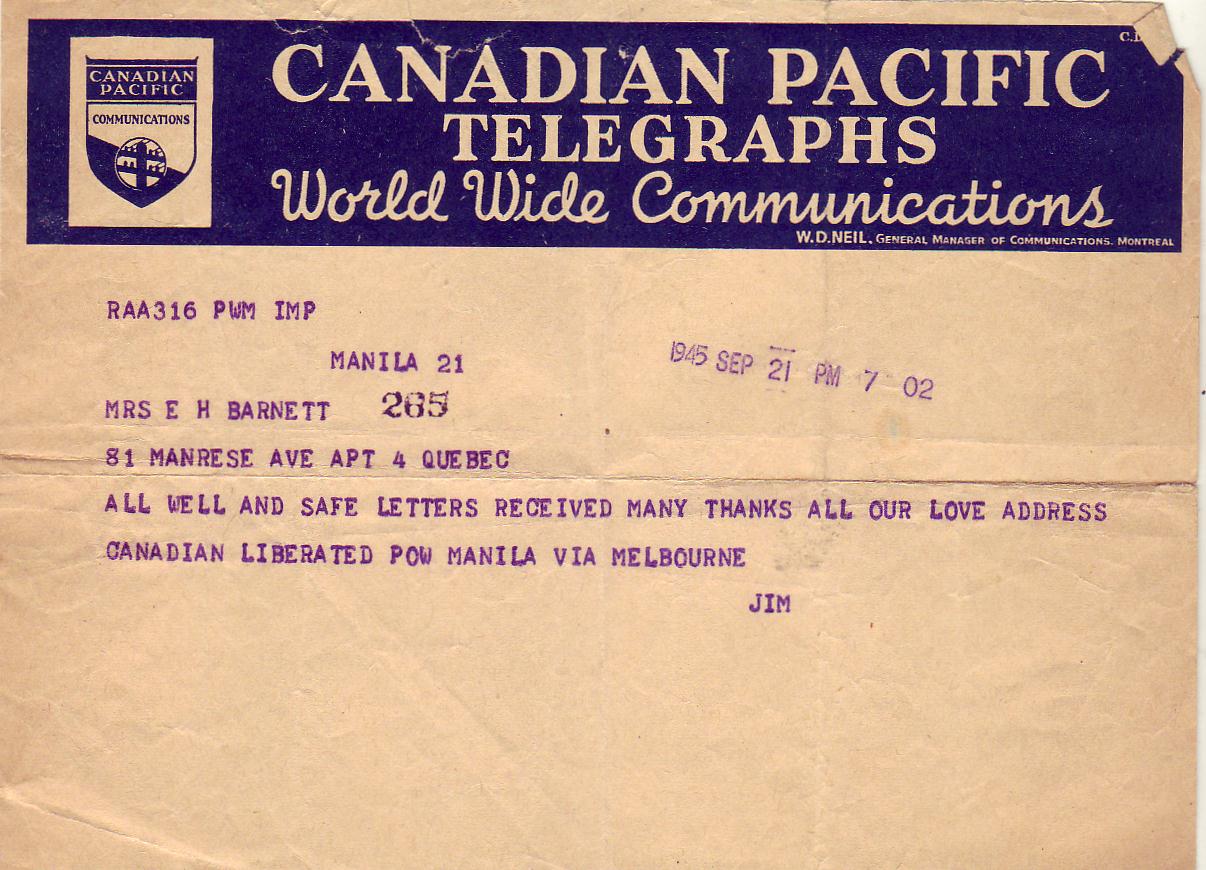
Figure 42: Telegram from Chaplain Barnett now in Manila to his family. – Courtesy of Gray Scrimgeour
The receiving of a telegram of the status of one’s loved one was big news. In a lot of instances, this news was shared with fellow citizens in the towns and cities by the news media. Local newspapers would print the announcement, as in the case of Mr. and Mrs. Calder of Hamilton who received such a telegram that was reported in an article in The Hamilton Spectator on September 24:5
Freed From Japs Hamilton Man Safe
…a telegram received from the director of records, Ottawa, reads: Pleased to inform you that B46619 Rfm. Vincent Calder, previously reported prisoner of war in Japanese hands reported safe in Manila, 21st of September. Condition is good and information follows when received…
The Ottawa Evening Citizen reported on October 9, 1945 that Lt. Peter MacDougall of the Royal Rifles of Canada, cabled his wife to let her know “that he has now reached Manila and hopes to be on his way home soon”. His first cable after Japan’s surrender was sent from Macao “to say he was safe”.
The September 22, 194 issue of the Lindsay Daily Post reported that the Nugent family had received the following cable from Manila:
Lt. Nugent Safe, Well In Manila
… The word comes in the form of a cable dated at Manila, and which was received by the family here Friday night. He wires in part "Hope to see you soon. I am well and fit. 'Bill'.
The McKay family of Lindsay, Ontario received a telegram from the Director of Records, Ottawa that was reported in the Lindsay Daily Post, on October 4, 1945:
LEARNS HUSBAND AT MANILA ON FIRST LAP OF TRIP HOME<…
Ottawa, October 3, 92029 C40618 Rfm. Andrew John McKay has now arrived Manila 1 October, 1945. Director of Records.
Royal Canadian Air Force (RCAF) Squadron Leader Leonard J. Birchall, who was shot down off the coast of Ceylon on April 4, 1942 and taken to Japan as a POW, arrived at Manila on September 10. The RCAF command in Ottawa sent his wife a telegram on September 12, which reads as follows:21
Ottawa Ont Sept 12/45 129 pm
Mrs. L. J. Birchall. Care Mr H. M. Loran Annapolis Royal
P1417 pleased to advise official confirmation has been received which states your husband@ seven seven five Wing Commander Leonard Joseph Birchall, D.F.C. has been released and is safe in Manila September Tenth. His condition good. There is no further information. Any further news will be telegraphed to you immediately.
RCAF Casualty Office.
Fig. 43 shows a photo of Lt. Col. M. W. McA’Nulty, who was in charge of the CRLG in Manila, talking to Sq/L Birchall.
[Ed Note: On April 4, 1942, RCAF Sq/L Birchall and his crew were shot down approximately 350 miles off the coast of Ceylon. They were able to get one message off to report that a Japanese attack force was sighted and heading for Ceylon. This attack force comprised of five aircraft carriers, four battleships, cruisers, destroyers, supply ships, transports and tankers. As soon as this message was sent, their Catalina reconnaissance plane was shot down, three of the crew perished in the sea. Birchall and the others were picked up, beaten and later taken to Japan as POWs. Canadian and British military authorities had presumed that all crew had perished. In 1943 an American POW, through a letter, had asked his mother to notify Birchall’s wife in St. John, New Brunswick that he was alive and a POW in Japan. Japanese authorities never notified the International Red Cross or the Swedish and Swiss delegates that Birchall and his remaining crew were POWs. Upon receiving word that they were alive, Canada promoted Birchall to Wing Commander and he was awarded the Distinguished Flying Cross (DFC). He was deemed the “Savior of Ceylon” as it was believed that the size of this Japanese attack force would have destroyed the British fleet and air bases and created a second Pearl Harbor at Ceylon.]
The first letters to LPOW’s in Manila from Canada left Ottawa on August 29 – flown there by the RCAF. Following is a newspaper article in the St. Catharines Standard on August 29, 1945:12
Letters to Hong Kong Prisoners
Ottawa, Aug. 29 (BUP). A dramatic delivery of letters from home is coming for members of the Quebec Rifles who were captured by the Japanese at Hong Kong, it was learned here yesterday.
Relatives and friends of the prisoners recently were canvassed and letters were written to the men so that they could get direct messages from their loved ones as soon as possible after their liberation. The letters will be the first delivered to the men without Japanese interference since Christmas 1940, when the Quebec Rifles, after a hopeless but gallant struggle, were taken prisoner by the Japs. The letters were flown to this city from Quebec by Corinne Kearnan, former lieutenant in charge of CWAC recruiting in Quebec military district (M.D. 5) and two hours later left by RCAF plane for the Pacific in charge Capt. Guy Gauvreau.
The first Canadians from Japan arrived in Manila at the 29th Replacement Depot on September 8 according to a September 8, 1944 article in The Hamilton Spectator,5 which states:
Manila Sept. 8… A group of Canadians now at No. 29 Replacement Depot here have received their first mail dated mid-August and written on the blue airmail forms which get the speediest delivery. Men who are hospital cases read their letters over and over and could hardly believe they were true…
These Canadians came to Manila on a ship with American LPOWs to the 29th Replacement Depot and were later transported to the 5th Replacement Depot. The 29th Replacement Depot was the main repatriation camp for American LPOWs as well as some Dutch.
In the excerpt above “written on blue air mail forms”, in Canada, family members of LPOWs received a letter from Colonel Ellis, Director of Repatriation, with the following contents:22
Since our last letter arrangements have been made for further special air mail service to our liberated prisoners of war in the Far East. Enclosed with this letter are six air letter forms endorsed as mail for Liberated Prisoners of War (Mail for LPW).
This is your supply for the time being to enable letters to be sent to the prisoner in whom you are interested from yourself and from other close relatives and friends of the prisoner. It is entirely at your discretion if you wish to allot some of these forms to others instead of using them yourself.
As the air mail facilities are heavily loaded and the number of letters that may be sent is strictly limited you are requested to see that these letters are spread over the next four weeks. No restriction is placed on the length of the letter. No enclosures are permitted.
Only the enclosed forms bearing the stamp "Mail for LPW" will be accepted. These may be mailed free of postage if mailed in Canada. If mailed elsewhere than in Canada, the air mail postage required by the country concerned should first be placed on the envelope in order to bring it to Canada.
These letters will be flown to Manila and handed to the prisoner at the earliest moment. The name and address of the sender is to be shown on the back of the air letter form above the notation “No enclosures permitted”. The letter should be addressed showing the prisoner’s
Regimental number (if applicable) Rank, Full Name, Unit,
Canadian LPW
7th Base Post Office
c/o Canadian postal Headquarters, Ottawa, Ontario.
The letter should be sealed prior to mailing.
Fig. 44 shows the special hand stamp with MAIL FOR L.P.W. in red between two bars.

Figure 44: Handstamp in red used on Liberated POW envelopes given to families in Canada. – Courtesy of the Ken Ellison Collection20
Fig. 45 shows the air letter form that was mailed in Canada and sent to Captain Gordon C. Gray, Royal Canadian Army Medical Corps, Canadian LPW, 7th Base Post Office, c/o Canadian Postal Corps Headquarters, Ottawa, Canada. The letter was sent and postmarked from Toronto on September 11. It was received in Ottawa on September 12, as indicated by the single-line date stamp. Mail to and from Canadian LPOWs was docketed in Ottawa prior to being dispatched. Mail address to the 7th Base Post Office was sent to Manila in a closed bag, via U.S. postal and military service. This letter was written prior to Captain Gray’s arrival in Manila, penciled on the back an arrival date of “20/9/45” (September 20, 1945). The form was hand stamped in black: PRISONER OF WAR MAIL / POSTAGE FREE in sans serif type.
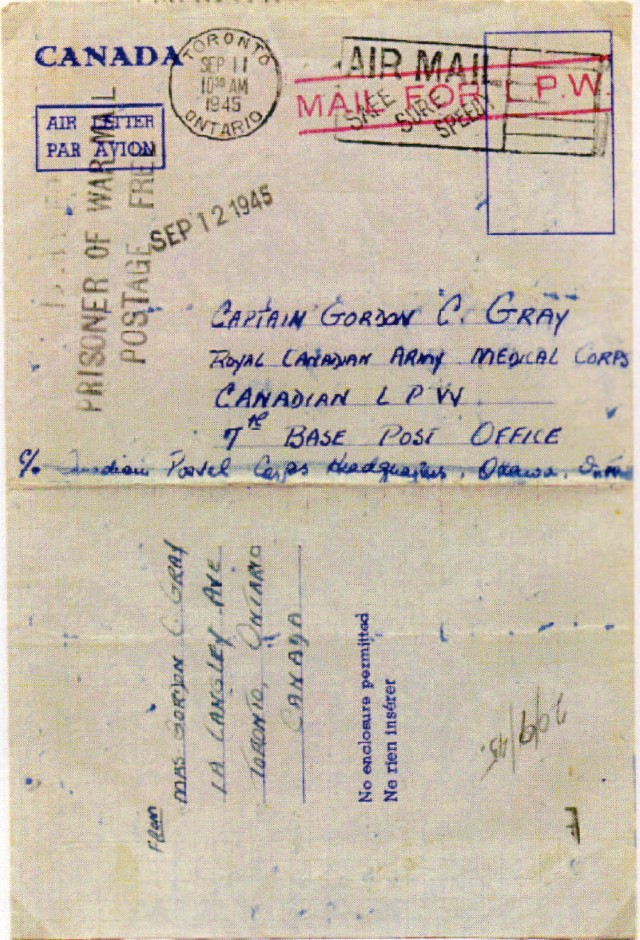
Figure 45: Complete air mail letter form given to families of Canadian LPOWs sent from Canada to Manila bearing a hand stamp with MAIL FOR L.P.W. in red. – Courtesy of the Ken Ellison Collection20
Prior to the issue of the blue air letter forms, the Canadian Red Cross prepared special air letter forms as stated in the Globe and Mail, on August 16, 19455 as follows:
Air Letter Forms Prepared to Contact Far East Prisoners,
Ottawa. Aug. 15 (CP) The Canadian Red Cross has prepared special letter forms for next of kin to communicate with prisoners of war and civilian internees formerly held by the Japanese and the first batch will go to the Far East by Aug. 25, the External Affairs Department announced today.
The air letter forms will carry 50 words and have space for replies and may be obtained from Canadian Red Cross offices.
The first batch will be flown to the Orient by the United States Army Air Force’s Transport Command and after its delivery, Canada will make her own arrangements for communications with Canadians formerly held by the Japanese and made up mostly of prisoners taken at Hong Kong.
In addressing the air letters, the External Affairs Department said the last-known address of the former prisoner, either the camp or the district should be used…
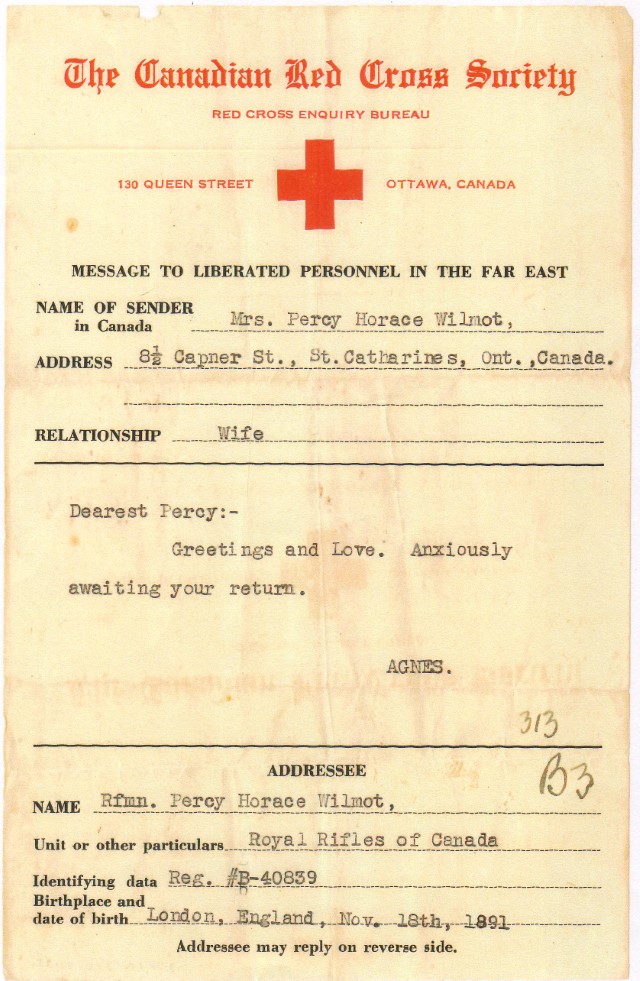
Figure 46: Special letter form prepared by the Canadian Red Cross. – CWM 20070117-074 George Metcalf Archival Collection, Canada War Museum.
As noted above “last known address of the former prisoner, either the camp or the district should be used”. This pertained to all mail for freed Canadians. Mail from Canada for the LPOWs was brought to Manila for sorting. This also included mail for those at Guam.
With the introduction of these special letter forms, at the Vancouver Red Cross office, four volunteer typists were kept busy the first day typing messages from Canadian family members. Fig. 46 shows one of these special letter forms made by the Canadian Red Cross. Its message reads:
Dearest Percy
Greetings and Love. Anxiously awaiting your return.
Agnes
Rfmn. Percy Horace Wilmot,
Royal Rifles of Canada
Reg. #B-40839
London,
England, Nov. 18th
1891
This special letter form would have gone in the first dispatch to Manila by the Canadian Red Cross on August 25. Fig. 47 shows a photo from the Winnipeg Free Press of a mother and daughter writing a note to her husband/father on one of these special Canadian Red Cross letter forms.
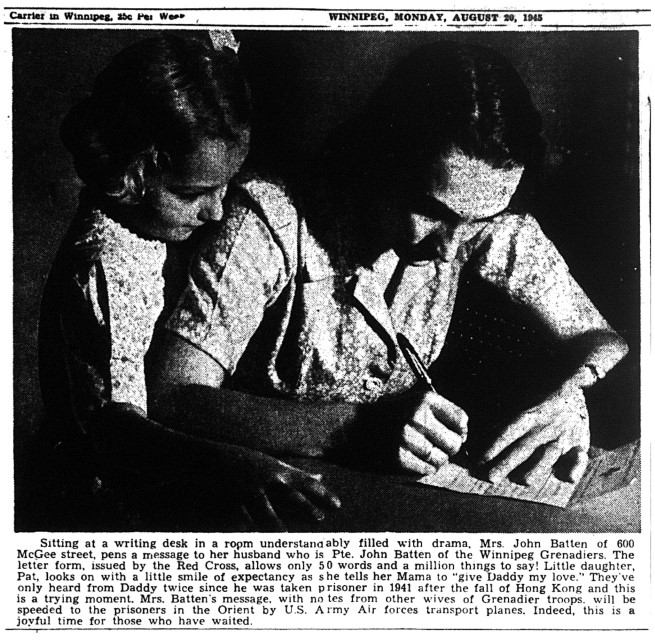
Figure 47: A mother and daughter writing a note to their loved one on a special Canadian Red Cross form. – Winnipeg Free Press, August 20, 1945.
As mentioned earlier, a writer was to use the LPOWs “last known address”. Fig. 48 shows a post card from the United States dated August 17, 1945 that was post marked at New York, mailed to Signalman William Allister #D116327 / Canadian Prisoner of War in Japan / Tokyo P.O.W. Camp No. 5 / Japan.
The message on the card is:
Aug. 17, 1945
Dear William:
Thank God war is over – Not over for us until you’re safely home. Mother, dad and family fine. Several old friends now home. Love Rhea and Milton
This post card was mailed after the war with Japan was over. It was sent to Manila, where it was sorted and sent to Signalman McAllister at Guam. Signalman McAllister came home from Japan via Guam.
Fig. 49 shows the front of a POW post card postmarked Winnipeg on August 18, 1945, addressed to L./Cpl. Martyn at Japan. The post card had been hand stamp LIBERATED / PRISONER OF WAR MAIL / POSTAGE FREE . Because of this hand stamp indicating postage free, this post card was sent to Ottawa for docketing purposes, as indicated by the date stamp SEP -1 1945. By the time this card left Ottawa and reached Manila, L./Cpl. Martyn had already left for Canada. The card was re-directed, and when it got to British Columbia the notation “Vic Mil Hosp” (Victoria Military Hospital) was added in red. The reverse of the card reads:
Dear Ford
We are all overjoyed at the news of victory. Hope you are well. We are fine. We’ll being seeing you soon.
Love and best wishes from all. Lillian
An article in the Hamilton Spectator on September 28, 19455 states:
Guam, Sept. 28. - A contingent of 426 Canadians liberated from prison camps in Japan was at Guam navy base to-day, awaiting transportation home. An additional 340 Canadians already have passed through Guam, homeward bound by sea and air.
…Red Cross Provides Funds
The prisoners have nothing but good words for their reception, which is really a welcome. They all have been able to send cables to their next-of-kin, although unfortunately they have received no mail, which has been directed from Canada to Manila reception organization for released prisoners. It is likewise impossible for them to draw money distribution of which is centered in Manila, but the American Red Cross is giving every prisoner $5.
On September 20, HMCS Prince Robert left Hong Kong and arrived at Manila on September 30. She carried over 1000 pieces of mail that were sent to the Canadians while they were in the POW camps.23 Over 200 bags of mail for Canadian prisoners who were held in Japan were released from Japan and forwarded to the repatriation group at Manila. POW mail was then sorted and delivered to the freed Canadians. If it was not possible to deliver it, it was returned to the sender.
Mail from Canada that had been held there for processing for the interned Canadian POWs was brought to Manila for sorting. This included mail for those at Guam.
Fig. 50 shows a POW air mail post card franked with a 10¢ Canadian stamp paying the airmail rate to a POW in Hong Kong.20 This was held by the Japanese and was never delivered to the POW while he was interned. Held mail such as this was taken to Manila by the Prince Robert and sorted there for delivery to the LPOWs, or if it could not be delivered it was returned to the sender. The addressee, Captain Thomson, could not be found because he was already on his way home to Canada. This air mail card was posted on June 9, 1945 and was received and held by the Japanese. Hand stamped in red RETURN TO SENDER FREE / BY ORDER OF POSTMASTER GENERAL / RECOVERED FROM JAPANESE . For some reason this post card was returned to India, where it was hand stamped in a black box INCONNU / UNKNOWN and two D.L.O. BOMBAY markings were applied in black in February 1946. Red Manuscript “R to S” (Return to Sender).

Figure 50: Post card mailed Quebec City on June 9, 1945 to a Captain Thomson, who was a POW at Hong Kong. The card could not be delivered to him at Manila and it was returned to sender. – Courtesy of the Ken Ellison Collection20

Figure 51: Post card to Captain Norris, who was on his way home. Note the SERVICE / SUSPENDED / RETURN TO SENDER hand stamp. – Courtesy of the Ken Ellison Collection20

Figure 52: Cover from Hamilton to a liberated Canadian merchant seaman in Manila, undelivered and returned to Ottawa and redirected to Transcona, Manitoba. – Courtesy David Tett24
Fig. 51 shows a POW post card dated July 1945 sent from Winnipeg to Captain Norris at a Hong Kong camp. Norris was on his way home when the card was delivered to Manila and sent back via England with the hand stamp “SERVICE / SUSPENDED / RETURN TO SENDER”.20
Fig. 52 shows a MAIL FOR L.P.W. cover posted at Hamilton, Ontario on September 16, 1945 to a Canadian merchant seaman, addressed as follows: “Radio Officer, Collett, Oswald, M. / Canadian-Merchant-Seaman-L.P.W. / 7th Base Post Office / c/o Canadian Postal Corps Headquarters / Ottawa, Ontario”. The 7th Base Post office was the address to which mail was sent when forwarded to Manila. It first was sent to Ottawa (see the single-line receiving hand stamp dated SEP 17 1945). The envelope is one of those supplied to family members of POWs. It was forwarded to Manila and returned to Ottawa because Radio Officer Collet could not be found, postmarked Ottawa M.P.O. 318. It then was redirected to Transcona, Manitoba, Transcona reciving date stamp January 11, 1946.
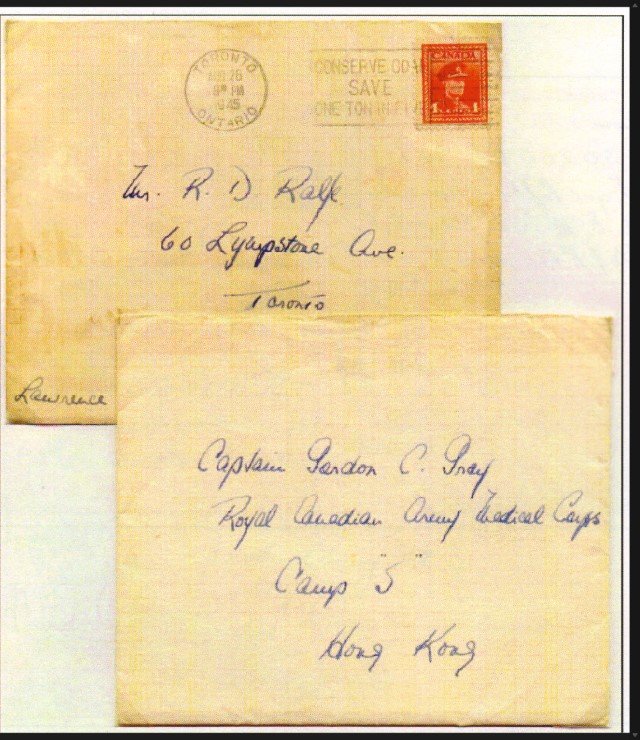
Figure 53: Favour cover to Robert Rolfe, a Canadian Red Cross officer who was on this way to Manila. – Courtesy of the Ken Ellison Collection20
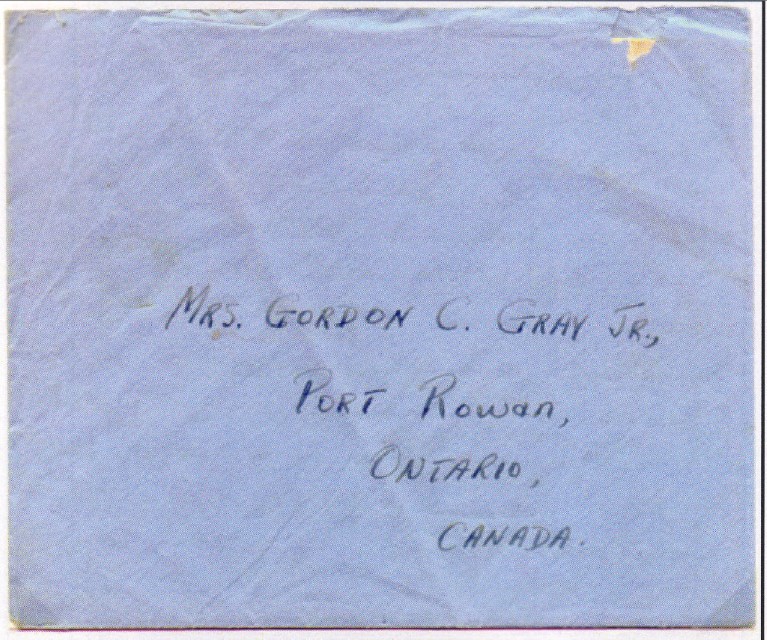
Figure 54: Favour cover to Mrs. Gray from her husband. It was delivered to her by a returned medical officer of Force “C”. – Courtesy of the Ken Ellison Collection20

Figure 55: Canadian air letter form with a 6¢ U.S. airmail adhesive cancelled by a U.S. Army Postal Service machine cancel. – Courtesy of the Ken Ellison Collection20
Fig. 53 shows a favour cover sent to Robert Rolfe, who was a Canadian Red Cross officer in Toronto and was being dispatched to Manila to assist with the Canadian LPOWs. Robert volunteered to take any mail given to him prior to his departure to the Canadians. Mrs. Gray, wife of medical officer Captain Gordon Gray, sent a letter under cover to Mr. Wolfe for delivery to her husband in Manila.20
Fig. 54 shows a favour cover from Captain Gray to his wife at Port Rowan, Ontario. The letter was written at Manila on September 18, 1945 and given to John Crawford, a Force “C” senior medical officer who went home in the first draft from Manila to Canada. Crawford delivered it by hand. Here are a couple of excerpts from the letter:20
I use all channels… to get letters home.
We arrived in Manila Bay on the morn of the 13th and anchored, apparently we weren’t expected & we did not dock until about 10:00 pm we got off about 11 & with great speed drove about 20 miles to this camp… The best thing of all was getting your lovely letter darling from Bob Rolfe

Figure 55: Canadian air letter form with a 6¢ U.S. airmail adhesive cancelled by a U.S. Army Postal Service machine cancel. – Courtesy of the Ken Ellison Collection 20
Fig. 55 shows a Canadian air letter stamped with a U.S. 6¢ air mail stamp and cancelled by a U.S. Army Postal Service / 1945 machine. These Canadian air letter forms were given to the liberated Canadians at Hong Kong when the HMCS Prince Robert arrived on August 30. Because it was franked with a U.S. air mail stamp, this cover was flown from Manila to San Francisco by either the NATS or ATC and then by commercial flight to Ottawa. There, it was docketed and forwarded to Port Rowan, arriving there on October 1, 1945. The U.S. Postal Service did not recognize free postage for LPOWs even if the covers were so endorsed. Therefore the U.S. military made available to the LPOWs air mail stamps that could be used on any postal stationery of any country (see figures 36 and 37, which show British and Australian air letters franked with 6¢ U.S. air mail stamps on mail to Canada).
Types of Hand Stamps
There were three distinct types of overprinted hand stamps reading “Liberated Prisoner Of War Mail Postage Free” used on the Canadian Air Letter forms supplied to Canadians at Manila. Type 1 had two lines of serifed lettering “Liberated Prisoner Of / War Mail Postage Free” (Fig. 56). These probably were printed in Ottawa because the three known examples all have the overprint in the same position, which would indicate printing on a printing press. They were waiting for the Canadians when they arrived in Manila.
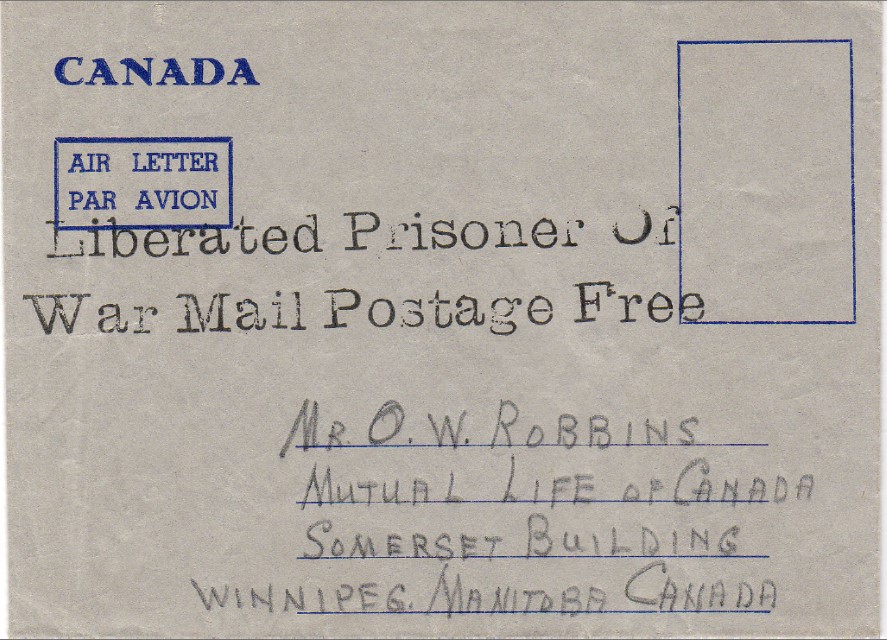
Figure 56: Cover showing the Type 1, two-line serifed overprint “Liberated Prisoner Of / War Mail Postage Free”, written by Major Baird on September 17, 1945.
The air letter shown in fig. 56 was written at Manila to a friend in Winnipeg on September 17, 1945 by Major K. G. Baird. Baird was a member of the Winnipeg Grenadiers. The message of this air letter reads:
Manila, P.I.
Sept. 17th , 45
Dear Orville
Have never been able to write a letter to you before. The nips weren't very co-operative.
We arrived here from Hong Kong five days ago and have been spending most of our time in eating and sleeping under most agreeable circumstances. We still have a lot to make up as far as eating goes and believe me we are working hard at it and getting results too. Have gained 20 pounds in the past five weeks. Now weigh 145. We expect to sail from Manila tomorrow for home. You can imagine how pleased we are. We are in an American camp, believe me the Yanks know how to do things in the right way. They have a system and work it, the results are astounding. They know what they want done and do it. Their equipment seems to be limitless and one can readily understand why the Nips folded up so soon after the Americans got organized and under way.
I hope you have been in the best of health and getting your fair share of business. I received one thousand cigarettes from the company. They were most gratefully received I can tell you. Please pass on my sincere thanks for them. Will be seeing you soon. Yours,
K. G Baird.
When quantities of these overprinted air letter forms were insufficient, the postal authorities produced a second type of handstamp. This second type was a three-line sans-serif rubber hand stamp used with black ink. The wording of Type 2 was LIBERATED / PRISONER OF WAR MAIL / POSTAGE FREE. These new forms were used in Manila for the troops to send mail back to Canada, and in Canada for the families to send mail to their men in Manila. Type 2 is divided into Types 2A, 2B, 2C and 2D all using the same font. The overall lengths of these subtypes differ. Type 2A measures 66mm in length, Type 2B measures 63 mm, Type 2C measures 64mm and Type 2D measures 63mm. Even though 2B and 2D measure the same, the word spacing is different. Fig. 57 shows the 4 sub-types of Type 2. It is believed that these were rubber hand stamps produced in Canada and flown to Manila along with blank Canadian air letter forms for hand stamping there. These handstamps were of the same style as those used on air letter forms supplied to the families in Canada. The heat and humidity in Manila would have affected the rubber; letters of several of the types had warped.
Fig. 58 shows the Type 2A hand stamp on an air letter form written by Chaplain James Barnett on September 20, 1945 while he was still in Manila and to be delivered to his wife in Quebec City.
 Type 2A
Type 2A
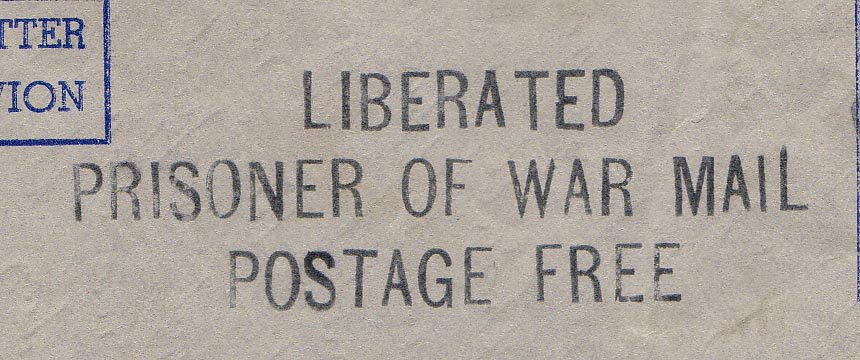 Type 2B
Type 2B
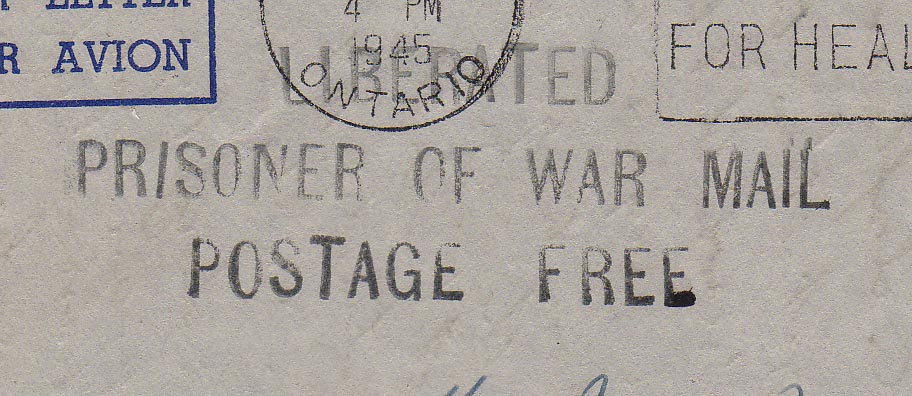 Type 2C
Type 2C
 Type 2D
Type 2D
Figure 57: Types 2A, 2B, 2C and 2D, 4 types of the sans serif rubber stamps. Their main differences are the spacing of the letters.
Fig. 59 shows the Type 2D hand stamp on an air letter form which was written on September 10, 1945, post marked at Toronto on September 11 and forwarded to Ottawa, where it was received and docketed on September 12, originally addressed to “Canadian Postal Corps Headquarters, Ottawa Ont.”, which was crossed out in blue pencil before the form was forwarded to Manila. Its contents start:
Dear Bob.
Owing to the shortage of these envelopes that were issued to us I had to cut out the address. . .
Type 3 is shown in Fig. 60. It has a smaller 3-line serfied type “Liberated Prisoner / of War Mail / Postage Free” in black. This rubber hand stamp probably was manufactured in Manila after Type 2A was damaged. The air letter form in this figure was written by Captain Gray, who was leaving on the U.S. Admiral C. F. Hughes. Boarding began on this ship on September 22nd; she sailed from Manila on the 24th. In his haste to board, Gray forgot to mail the letter, discovered it among his belongings and mailed it upon his arrival in Canada. The USS Admiral C. F. Hughes arrived at Victoria on October 9, 1945. A postmark over the handstamp makes the reading difficult (see the enlargement of the handstamp).
Fig. 61 shows a Canadian air letter form, with the Type 2D hand stamp, postmarked by the Australian Army P.O. 241 on October 3, 1945. It was unusual for the Australians to process Canadian mail because this was to be handled by Canadians. Possibly the sender dropped it into the wrong mail box. The cover was sent to Canada by the regular forces mail service.
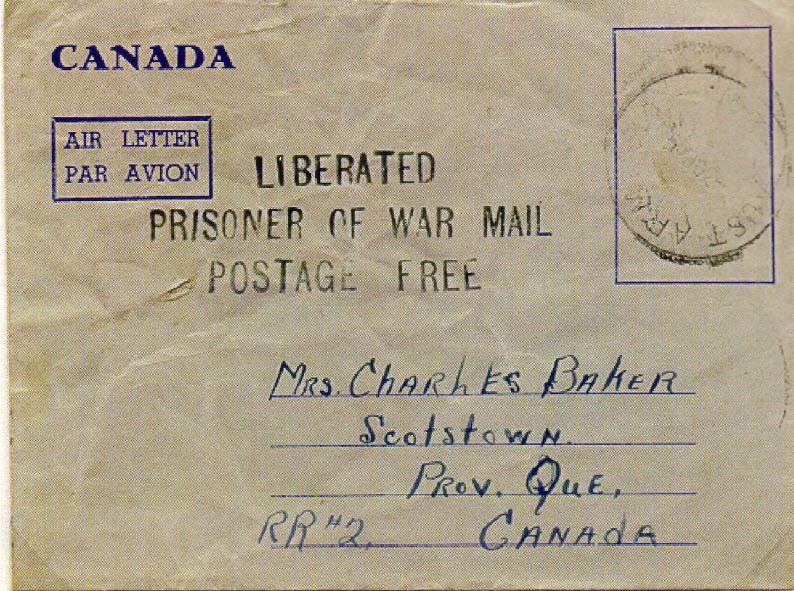
Figure 61: Canadian air letter form postmarked with the Australian Army P.O. 241 cancel. – Courtesy of the Ken Ellison Collection20 Click for larger view
Ottawa Docketing
Mail from Canadian LPOWs was docketed and recorded in Ottawa before it was sent to family members. Fig. 62 shows a date stamp OCT 12 1945, indicating that this air letter was received and accounted for in Ottawa on that date. The letter was written at Manila on September 24, 1945 by Chaplain James T. Barnett. Chaplain Barnett came home on the USS Joseph T. Dickman. The LPOW hand stamp is Type 2B.
Fig. 63 presents a Canadian air letter postmarked at St. Catharines, September 24, 1945. It was to Signalman Dowling, Canadian Liberated P.O.W. Manila via Melbourne. This air letter does not have the two- or three-line “Liberated Prisoner of War Mail Postage Free” hand stamp, only the red “MAIL FOR L.P.W.” This marking in red entitled the letter to free postage. Since it was going to a Canadian LPOW, this cover first went to Ottawa for docketing purposes and then was forwarded from there. OCT 1 1945 was the Ottawa docketing date stamp. The address “Manila via Melbourne” was crossed out in blue crayon at Ottawa because they knew that Dowling was on his way home. This would have been put in a closed bag and sent to the port of his arrival, so that it would be waiting there for him. Dowling came home from Manila via the USS Admiral Rodman, arriving at Vancouver on October 7, 1945. Here is an excerpt from the letter:
Dear Lawrence
Well here I am at last with a letter, I hope you will be able to read it as my writing has’’t improved any. We just received your telegram yesterday and we were sure glad to get it. We had received three from Ottawa before that but it was sure swell to get one from you personally. It will be still better when you back here again. Everybody at home if fine Art is still in Holland but expects to be home for Xmas…
Floyd (P.S. I am still single)
Fig. 64 shows a cover similar to the previous figure except that the air letter has been paid with 7¢ postage for air mail service. Since the cover was paid with postage, it did not go to Ottawa for docketing purposes and went straight to Vancouver, B.C. MPO 1106, post marked St. Catharines on October 1, 1945. This cover was awaiting Dowling when he arrived in Vancouver.

Figure 65: Photo of Signalman Dowling showing his parents a Japanese sword. – St. Catharines Standard.25
In Fig. 65, Signalman Larry Dowling shows his parents a war souvenir, a Japanese sword.
The telegram in Fig. 66 has the hand stamp “RECEIVED AT PARLIAMENT BLDG., / RECU A HOTEL DU GOUVERNEMENT” in blue. This indicates that telegrams were sent to Ottawa for docketing prior to being sent to the recipient.
The Way Home
The Australians worked with the Americans to set up the transportation of returning LPOWs. This was an enormous task and it required careful planning. Table 1 is a list of repatriation ships that left Manila with Canadians. American, British and Canadian ships were used in this repatriation duty. The British and Canadian ships brought the Canadians back to British Columbia, while the American ships came to either British Columbia or San Francisco. The Royal Canadian Army assigned a contingent to San Francisco, where they supplied British and Canadian LPOWS with new uniforms and some back pay before they traveled north to Canada. Canadian Red Cross personnel also were assigned to San Francisco to assist in repatriation matters. Canadians who came home via San Francisco travelled north to Canada via special trains. All prisoners of war and civilians arriving at United States west coast ports and destined for Canada were sent to Vancouver.25 Upon arrival in Canada, the Canadians usually were taken to either McCauley Point or Gordon Head Camps in Greater Victoria.
When it was time to begin the journey home, either the LPOW or the government would notify the family that their soldier was on their way. Fig. 67 shows a telegram sent to Rifleman Wilmont’s wife, dated October 11, 1945, which reads:
Official information has been received that B40839 Rifleman Percy Hoarce Wilmot embarked Manila aboard HMS Glory ninth October expected time of arrival Vancouver twenty seventh October.
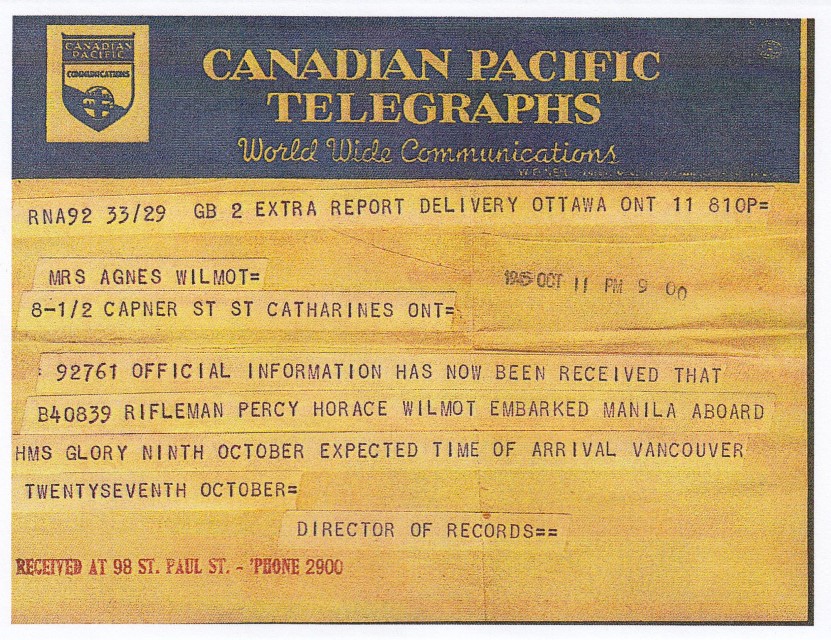
Figure 67: Telegram from Ottawa to Mrs. Wilmot advising that her husband was on his way home. – CWM 20070117-076 George Metcalf Archival Collection, Canada War Museum.

Figure 68: Newspaper article about the USS Ozark arriving at San Francisco, listing the names of the BC soldiers of “C” Force. It also lists the Canadians from BC who were on the USS Admiral Rodman, which was to arrive at San Francisco. – Vancouver Sun, October 3, 1945.
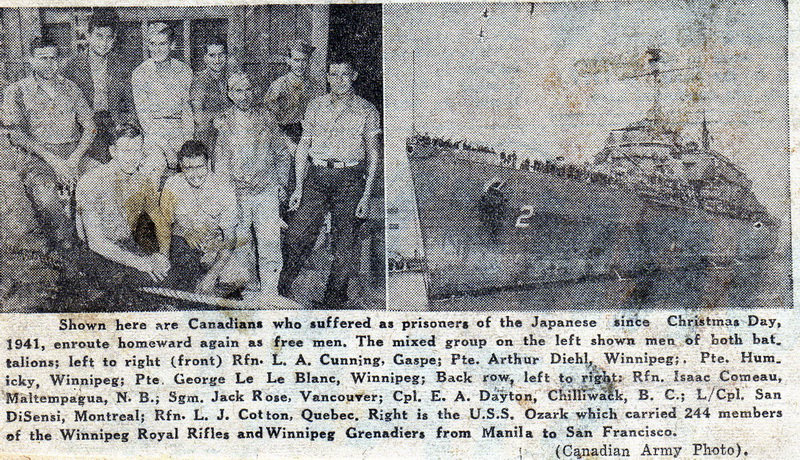
Figure 69: Canadian Army Photo of the USS Ozark and LPOWs.27
USS Ozark – September 8
The first American ship carrying British LPOWs to leave Manila and arrive in the U.S. was the USS Ozark, which left Manila on September 8 and arrived at San Francisco on October 2. She carried 950 American, British and Canadian ex-internees (244 were members of the Winnipeg Grenadiers and the Royal Rifles of Canada).27 Fig. 68 shows a newspaper article about the Ozark arriving at San Francisco, listing the names of the members of “C” Force from British Columbia. Fig. 69 is a Canadian Army Photo of the USS Ozark and LPOWs.
USAT General Langfitt – September 15
The first American ship to leave Manila for Canada was the USAT General Langfitt, which left September 15 and arrived at Esquimalt on October 3. She carried 289 British, 10 Canadians and 2,252 Americans. The British and Canadians disembarked at Esquimalt and the Langfitt then proceeded to Seattle. Fig. 70 shows a newspaper article written while the General Langfitt was at sea. Fig. 71 shows a photo of two free LPOWs waving from the Langfitt as she enters Esquimalt.
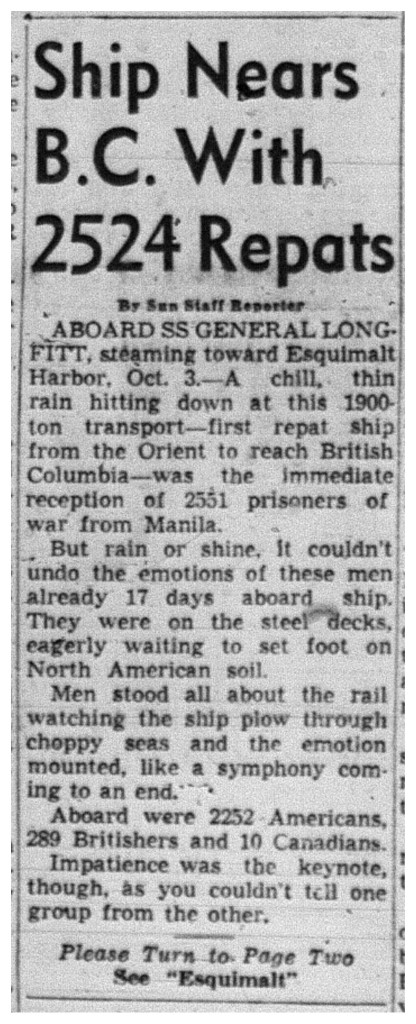
Figure 70: Newspaper article listing the names of the Canadians aboard the Langfitt. – Vancouver Sun, October 4, 1945.
USS Admiral Rodman – September 18
The USS Admiral Rodman left Manila on September 18 and arrived at San Francisco on October 3, 1945. Fig. 68 lists the men from British Columbia on this ship.
The September 18, 1945 issue of the Hamilton Spectator,5carries this story:
CANADIAN DRAFT LEAVES MANILA IN HIGH SPIRITS
Members of Hong Kong Garrison Start Home Horror Stories Told.
William Stewart, Canadian Press War Correspondent
Manila, Sept. 18. A reduced draft of 25 Canadian officers and 80 other ranks, members of the Hong Kong garrison, who were liberated after nearly four years in Japanese hands, moved out of a reception depot here to-day, to board a ship for their homeward trip, possible via San Francisco.
Earlier 100 other prisoners were warned to stand by for air passage home.
The prisoners, most of them wearing United States uniforms, some draped in waterproof ponchos boarded trucks at the depot which took them some 18 miles to Manila docks, where they were due to board the American ship Admiral Rodman.
All were in good spirits over their good fortune, although the rainy day meant postponement of the departure of those due to fly home.
USS Gosper – September 21
The USS Gosper was scheduled to leave Manila on September 21 and to arrive in the United States, but, due to a lack of docking space available in San Francisco at its scheduled time of arrival it was ordered to proceed to Seattle, where the captain then decided to proceed to Victoria and disembarked the British and Canadian LPOWs on October 11. The Gosper then proceeded to Seattle to disembark the American LPOWs. The Gosper repatriated 1,936 American, British and Canadians. The British who came aboard the Gosper traveled across Canada by train to Halifax and boarded the Isle de France for their trip to Great Britain. The Isle de France arrived at Southampton on October 30. Fig. 72 shows a sad scene of a burial at sea of a Grenadier who died aboard ship.
USS Admiral C. F. Hughes – September 24
The USS Admiral C. F. Hughes left Manila on September 24, 1945 and arrived at Victoria on October 9. Amongst her LPOWs were 465 Americans, 1,263 British, 141 Canadians and 12 British and 18 U.S. army nurses who were confined to Japanese prison camps. Fig. 73 shows three members of the Winnipeg Grenadiers who sailed from Manila on the USS Admiral C.F. Hughes.

Figure 73: Photo of three members of the Winnipeg Grenadiers who sailed from Manila on September 24, 1945 aboard the USS Admiral C. F. Hughes, arriving at Victoria on October 9. Left to right: Captain D. A. Golden, Lieut. T. A. Blackwood and civilian Y.M.C.A. Supervisor George Porteous. – Regina, The Leader Post, October 10, 1945.
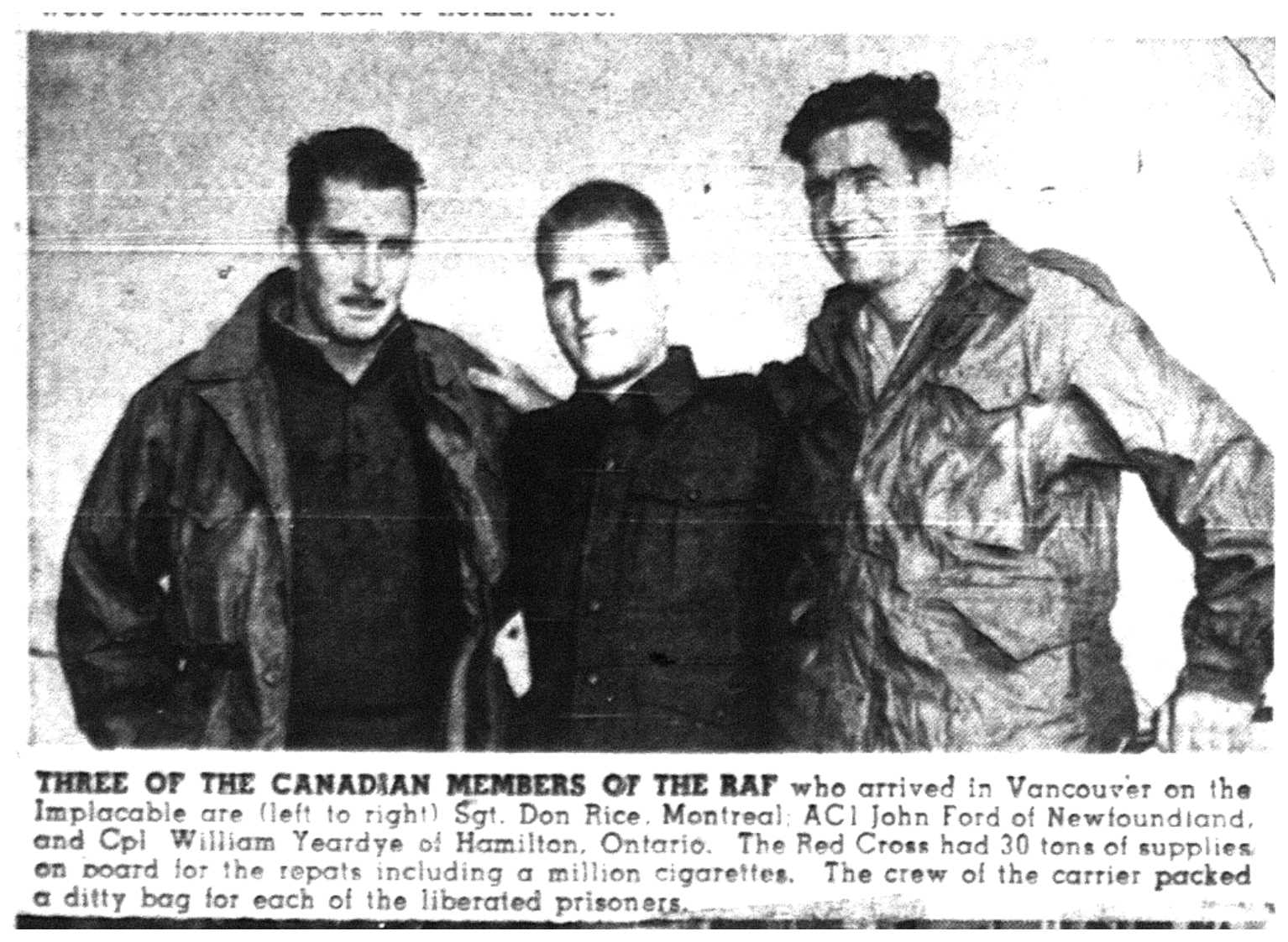
Figure 74: Photo of three Canadians who arrived at Vancouver aboard the Implacable. These three Canadians served in the RAF. Left to right, Sgt. Don Rice of Montreal, AC1 John Ford of Newfoundland and Corporal William Yeardye of Hamilton, Ontario. – Canadian Army Photo, Vancouver Sun, October 11, 1945.

Figure 75: Photo of a Canadian officer being helped aboard the Prince Robert at Manila. – Courtesy of LCMSDS18
HMS Implacable – September 25
Two British aircraft carriers came to Canada with LPOWs. The first British ship to leave Manila for Canada with British LPOWs was the aircraft carrier HMS Implacable, which left September 25, 1945 and arrived at Vancouver, British Columbia on October 11, with 2,127 British LPOWs and 5 Canadians who had served in the British military
No members of “C” Force were on aboard the Implacable. Many Canadians served in the British military, mainly in the Royal Air Force (RAF); when the Implacable arrived at Vancouver from Manila, on board were three Canadians who were members of the RAF (see Fig. 74). Even though they were Canadians, they had to go back to the United Kingdom for discharge.
USS Joseph T. Dickman – September 25
A research document entitled History of The USS Joseph T. Dickman (APA-13) / 10 June, 1941 - 1 October, 194528 states:
On 24 September, 1945, the U.S.S. JOSEPH T. DICKMAN, APA-13, had the most pleasant duty assigned to it since being commissioned. Under orders from CINCPAC the Army Port Command at Manila embarked 5 U.S. Naval Officers as passengers: 108 U.S. Army Officers, 54 British Officers and 12 Canadian Officers plus 511 British, 32 Canadian enlisted personnel and 159 U.S. civilians, all ex-allied prisoners of war for transportation to the west coast via Pearl Harbor. These officers and men had endured untold tortures and suffering while under the Japanese and were among the first to be returned home. Among them were four British enlisted army personnel who, after three and one half years as war prisoners, started their trip home on the U.S.S. JOSEPH T. DICKMAN, the very same vessel which, in 1941, carried them from Halifax to Bombay, India, on the beginning of their war mission.
The USS Joseph T. Dickman left Manila on September 25 and arrived in San Francisco on October 16, 1945 with her contingent of LPOWs.
HMCS Prince Robert – October 2
The Prince Robert left Manila on October 2 and arrived at Esquimalt on October 20 with 27 Canadians, 17 British, 1 RCAF officer and 15 Roman Catholic Missionaries, all from the far east.29 Fig. 75 shows Canadian army officers aboard the Prince Robert. Fig. 76 shows a photograph of HMCS Prince Robert arriving in Esquimalt.
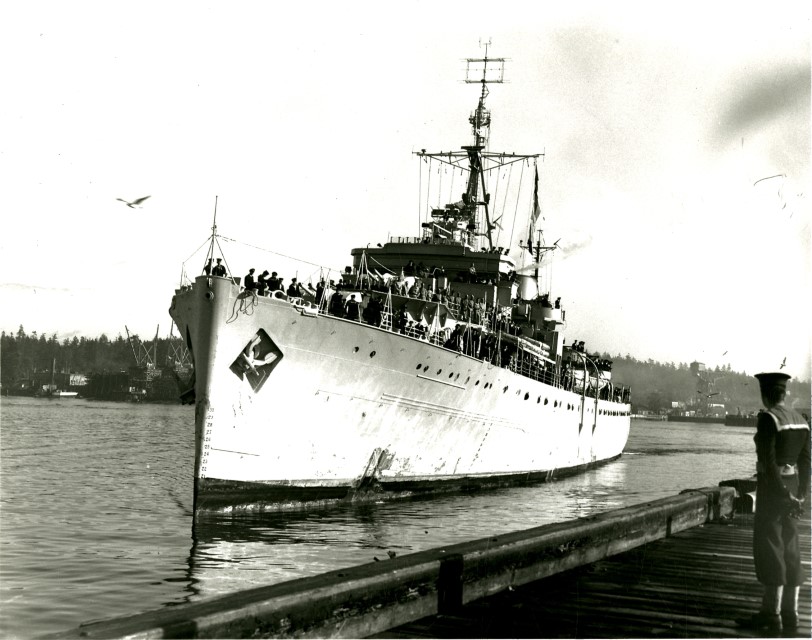
Figure 76: Photo of HMCS Prince Robert arriving at Esquimalt, B.C. – Courtesy of LCMSDS18
HMCS Glory – October 9
The last British ship to come to Canada with British and Canadian LPOWs was HMS Glory. She left Manila on October 9 and arrived at Esquimalt on October 26 with 1,304 British and 154 Canadians of which 37 were hospital cases (117 were deemed fit). Fig. 77 shows a photo of “Embarkation of British and Canada ex prisoners of war on the aircraft carrier HMS Glory bound for Canada and the United Kingdom. Australian Sisters at the gangway of the landing craft infantry (LCI) to farewell the ex-prisoners of war.”
Fig. 78 shows the embarkation of British and Canadian ex prisoners of war on the aircraft carrier HMS Glory, bound for Canada. An Australian sister farewells one of her British patients at the gangway of the landing craft infantry (LCI). She is Lieutenant M. MacQueen of the 2/5th Australian General Hospital attached to 248 United States General Hospital from the 3rd Australian Prisoner of War Reception Group.
An article in the Hamilton Spectator on October 8, 19455 stated the following:
Last Canadians In Manila to Sail On Plane Carrier
By William Stewart
Manila, Oct. 7 (CP). All the Canadian prisoners of war remaining in Manila, including the 38 in hospital, are due to leave tomorrow for home aboard the Royal Navy aircraft carrier Glory.
With their departure the bulk of the liberated Canadian prisoners in the Pacific area will be en route home or within a few days of sailing.
Of the original Canadian contingent which took part in the siege of Hong Kong in December, 1941, 1,344 other ranks, including a few Canadians serving with the British forces and 69 officers have been recovered. The deaths of one officer and 42 other ranks, which previously were not known, have been established.
(Previously Manila dispatches gave the size of the Canadian Hong Kong force as 1,972 men and two nursing sisters, since repatriated. The Canadian Defense Department has said the contingent numbered 1,985 officers and men. The department reported 1,689 were taken prisoners in the fall of the garrison. A number died in captivity.)
The Canadian group for repatriation of war prisoners also recovered 21 RCAF personnel and five merchant seamen. But it has been unable to obtain data about four soldiers, five members of the RCAF, 15 merchant seamen and two members of the Royal Canadian Navy, some of whom may have been recovered by forces operating from the Allied Southeast Asia Command.
About 130 Canadian civilians, most missionaries, have been located, but there is no information here about a considerably larger number who also may be recovered on the Asiatic mainland.
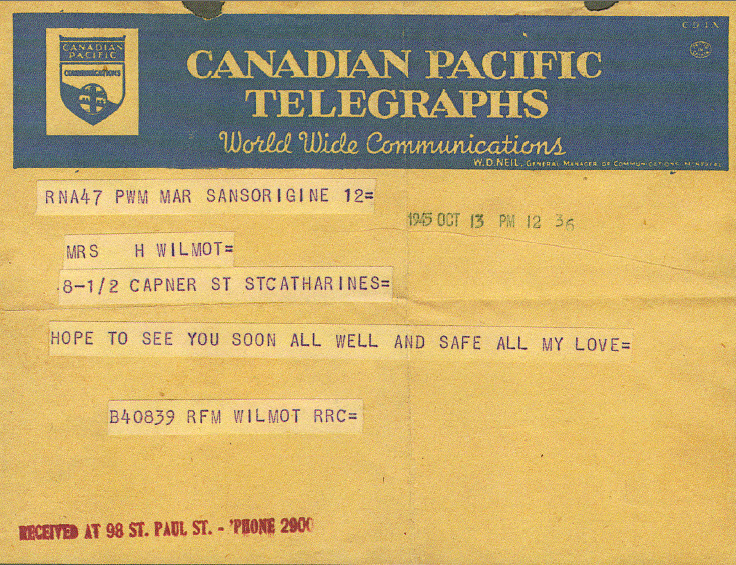
Figure 79: Telegram from Percy Wilmot aboard HMS Glory to his wife. – CWM 20070117-076 George Metcalf Archival Collection, Canada War Museum.
Fig. 79 shows a telegram from Percy Wilmot aboard HMS Glory to his wife at St. Catharines, received October 13. Here is its message: “Hope to see you soon all well all my love B40839 RFM Wilmot RRC”. Note at the top left of the telegram “RNA47 - RN (Royal Navy) PWM mar Sansoriginee”. Having PWM insured that Mrs. Wilmot did not have to pay fees to receive this telegram.
A newspaper article from the Globe and Mail, October 27, 1945,5 states:
Glory Lands 1,400 British Repats,
Some Canadians. Esquimalt, B.C.
Oct. 26 (CP). The 18,000-ton British light aircraft carrier Glory docked here today with nearly 1,400 repats aboard, including 121 military personnel and several civilians.
There were 140 hospital cases included 25 stretcher cases. The Canadians, except for one member of the RCAF, were members of the Royal Rifles of Canada, or the Winnipeg Grenadiers, and nearly all were in the same prison camp of Kasawabe, Kyushu, Japan for 22 months. They were the last Canadians to leave Manila (Oct. 9) and stopped one day at Honolulu.
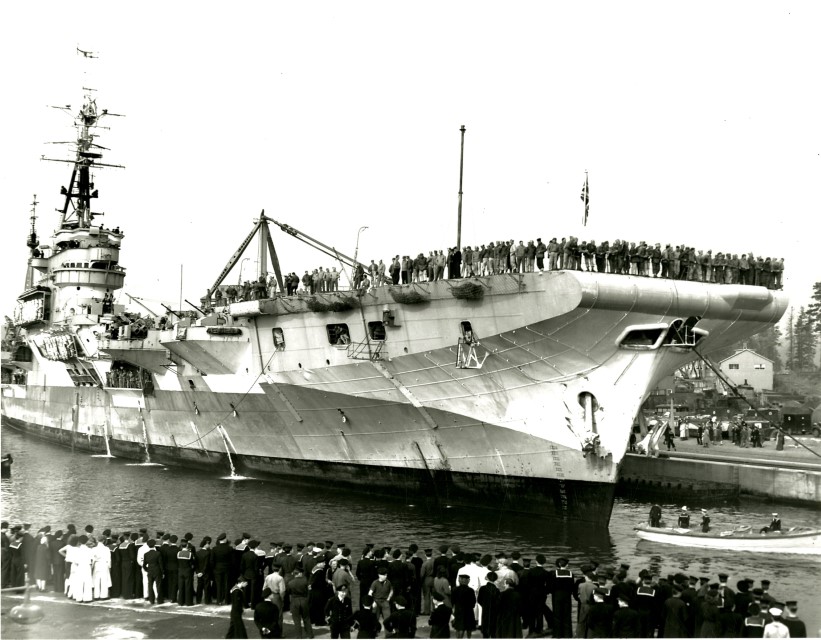
Figure 80: Photo of the British aircraft carrier Glory arriving at Esquimalt, B.C. – Courtesy of LCMSDS18
Glory arriving at Esquimalt on October 27. The Glory transported 1,460 liberated POWs, of which there were 37 Canadians who were ill and 119 who were fit.
Upon their arrival at Esquimalt, mail was awaiting the Canadians. Family members in Canada were given a set of air letters having the black “Liberated Prisoner of War Mail Postage Free” deleted as LPOWs were not considered POWs any longer. These air letters just had the MAIL FOR L.P.W. hand stamped in red with two bars; this enabled free postage, as shown in Fig. 44.
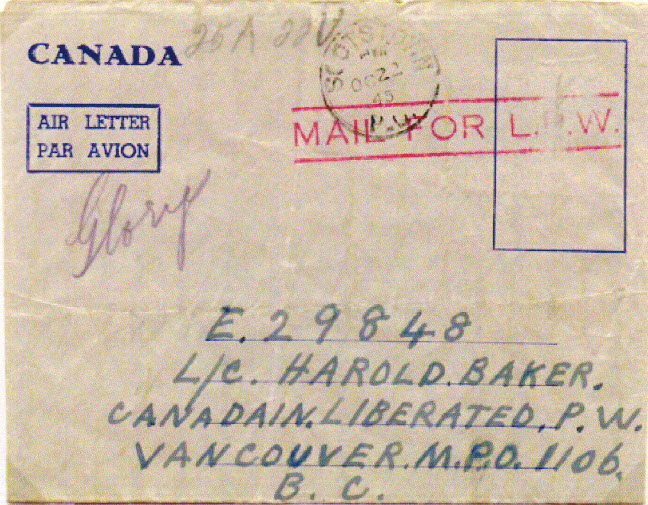
Figure 81: Canadian air letter sent to an arriving Canadian aboard the Glory. – Courtesy of the Ken Ellison Collection.20
Fig. 81 shows a Canadian air letter that was sent to Vancouver addressed “L/C Harold Baker / Canadian Liberated, P.W. / Vancouver, M.P.O. 1106 / B.C.” It was pencilled “Glory”. The air letter was written at Quebec on October 22 and sent in care of M.P.O. 1106 (Vancouver). This cover arrived after the Glory had docked and its passengers gone to the Macaulay Point reception centre; from Vancouver it was forwarded to Victoria, B.C. and delivered to L/C Harold Baker at Macaulay Point.
HMCHS Letitia – November 12
The last Canadian ship to return from Manila was the Royal Canadian Navy Hospital Ship HMCHS Letitia, which left Manila on November 12 and arrived at Vancouver on December 6.

Figure 82: Newspaper article referring to Private Mossman coming home. Halifax Herald, December 6, 1945.
The Letitia brought the Canadian and British repatriation teams back to Canada as well as the last member of “C” Force, Private Earl Mossman of Lunenburg, Nova Scotia. Private Mossman was liberated from the Japanese POW camp at Kyushu and taken to Manila. Due to his medical condition, the doctors would not let him leave earlier. Also aboard the Letitia were 23 British LPOWs, a Norwegian merchant marine, and 8 French and Irish priests. Fig. 82 shows a newspaper clipping with the notice that Private Mossman was on his way home.
On October 3, 1945, the Ottawa Evening Citizen had this story:
All of the 30,805 known Allied war prisoners and civilian internees from Japan and Korea have been evacuated… The list of those evacuated includes 10,099 Americans, 957 Canadians, 9,370 from the British Isles, 2,108 Australians, and 581 from Holland.
This total does not include the liberated prisoners from China, Manchuria, Formosa and Hong Kong.
Welcome Cards
Two "Welcome" cards were printed and given to the LPOWs on their arrival in BC. One card was printed by the Government of the Province of British Columbia and the other by the City of Victoria. Fig. 83 shows the welcome card presented by the Mayor and Council of Greater Victoria, printed brown on white card.
A second Welcome card was given to the British and Canadian LPOWs upon arrival. The card in fig. 84 was printed in blue and presented by the Government of the Province of British Columbia.
Figures 83 and 84 were presented to the freed POWS upon arrival in Canada. As they traveled across Canada, the cities of Calgary and Winnipeg also issued Welcome cards. Fig. 85 shows a card presented to Canadian LPOWs at Winnipeg (Winnipeg of course was the home of the Winnipeg Grenadiers).
Conclusions
This article describes in detail the arrangements made for returning liberated POWs from Asia to Canada after the end of World War II. It also discusses the procedures used to expedite and deliver their mail. No other single source lists all the ships used for transporting these LPOWs. Quotes from contemporary newspapers should strengthen the readers’ understanding of this major undertaking.
Acknowledgements
I would like to thank Gray Scrimgeour for his encouragement in this project and for editing the manuscript, as well as for the use of some of the material from his collection. Thank you to Sam Chiu for the use of material from his collection and to the late Ken Ellison and the British North America Philatelic Society for use of material from Ken’s publication The Canadian Army’s Hong Kong Story 1941–1945. I thank Robert Toombs for his assistance with the transportation of the mails from the Far East to Canada, and the Hong Kong Veterans Commemorative Association for their encouragement. Kathy Hartley, Librarian at the V.G. Greene Philatelic Foundation Library was so nice and understanding. I acknowledge the assistance of many museums: the Canada War Museum, Niagara Military Museum, St. Catharines Museum and Archives, Imperial War Museum, and the Australian War Memorial. Newspaper archives contain much valuable contemporary information. The newspaper files I used were the St. Catharines Standard /*comment*/ at the St. Catharines Public Library; the Niagara Falls Evening Review at the Niagara Falls Public Library; and the Hamilton Spectator, Winnipeg Free Press, Ottawa Evening Citizen, Montreal Star, Toronto Globe and Mail, Toronto Daily Star, Regina Leader Post, and Winnipeg Evening Tribune available on microfilm at the Toronto Reference Library, and the Victoria Times and Daily Colonist and the Vancouver Sun from the Library of the University of Victoria. The City of Kawartha Lakes Library has relevant newspaper clippings digitized and available. The Canada War Museum has several correspondences and diaries of Canadian POWs who were captured at Hong Kong and repatriated through Manila and Guam. Newspaper clippings of the Hamilton Spectator, the Toronto Globe and Mail and some other Canadian papers are freely available on the internet on the : Canada War Museum web site. Australian newspapers have been digitized by the National Library of Australia, and are available for use, free on the internet through the National Library of Australia.
References and Endnotes
1. Transcripts from newspaper articles and personal letters are reproduced exactly as they appear. Spelling and grammar may vary from newspaper to newspaper, and personal letters may have spelling and grammatical errors.
2. www.airmuseum.ca/rn/prstory07.html
3. Hong Kong Airmails 1945<-1995, by N. Halewood, Hong Kong Study Circle.
4. www.khs.org.au/pdfs/2014newsletter.pdf
5. Canada war Museum newspaper collections
6. Forged in War, A History of RAF Transport Command 1943-1967, H. Wynn, Air Historical Branch (RAF) Ministry of Defence (1996).
7. Naval Air Transport Service Command, Pacific Wing, System Schedules, 15 September 1945.
8. Material from the Lindsay Chitty collection.
9. History of the Australian Military Postal Services 1814-1950 by Edward B. Proud, Published by Proud-Bailey Co. Ltd.
10. British National Archives, War Diary of British Section, No. 3 Australian P/W. Reception Group. Aug. 1945 to Jan. 1946.
11. War Diary or Intelligence Summary of the Canadian Radar Detachment on Loan to Australian Military Forces. – Department of History and Heritage (DH&H), Canadian Armed Forces Archives, at Holly Lane in Ottawa.
12. /*comment*/ St. Catharines Public Library, Reference Section, Ontario.
13. Regina Leader Post, September 1, 1945.
14. American and Allied Personnel Recovered From Japanese Prisons, A Pictorial History Record, Replacement Command, AFWESPAC, 11 November 1945, Manila, P.I.
15. R.H. Webb, A Guide to Canadian Military Postal History 1636-1967, Chapter 18, edited by R. Toombs, G. Scrimgeour and B. Plain, Postal History Society of Canada (2014).
16. National Library of Australia, www.trove.nla.gov.au
17. www.royalnavyresearcharchive.org.uk
18. Photo courtesy of the Laurier Centre for Military Strategic and Disarmament Studies, “LCMSDS”.
19. Niagara Falls Public Library, Ontario.
20. The Canadian Army’s Hong Kong Story 1941-1945, an exhibit prepared by Ken V. Ellison, published by the North America Philatelic Society Ltd.
22. Beyond The Call, D.B. Penny, Hong Kong Veterans Commemorative Association.
23. Globe and Mail issue dated October 1, 1945.
24. A Postal History of the Prisoners of War and Civilian Internees in East Asia During the Second World War. Volume 4. Hong Kong and China 1941-1945. Captives in Cathay by David Tett, FRPSL. BFA Publishing, P.O. Box 34, Wheathampstead, Herts. AL4 8JY, www.fepowmail.com.
25. St. Catharines Museum and Archives
26. The Toronto Globe and Mail, September 21, 1945.
27. Hong Kong Veterans Commemorative Association (of Canada).
28. History of The U.S.S. Joseph T. Dickman (APA-13) 10 June, 1941 - 1 October, 1945, Page 33, by Donald K. Dewar.
29. Globe and Mail issue dated October 22, 1945.




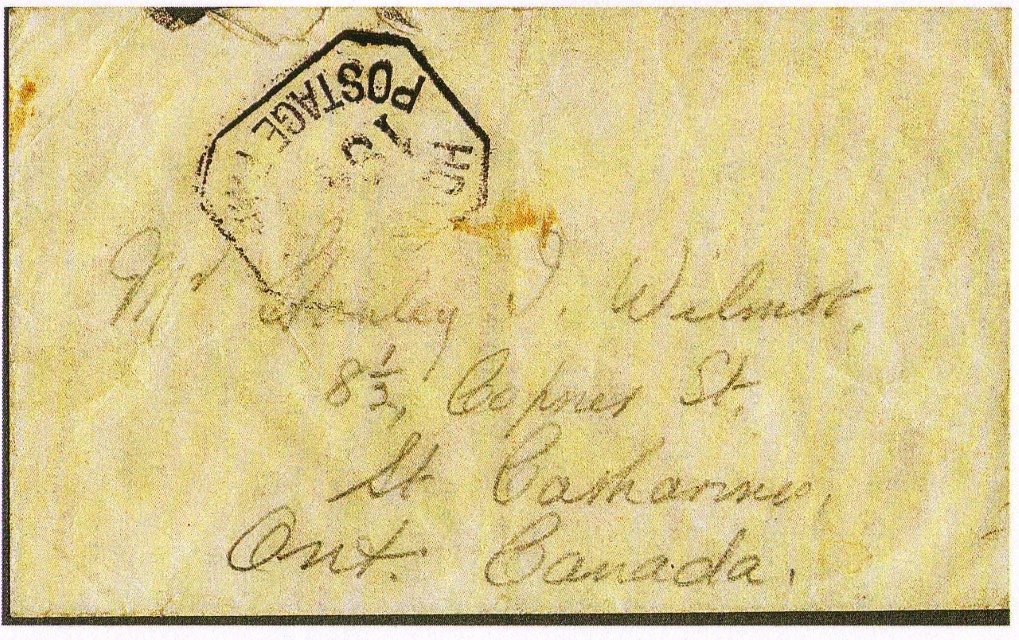
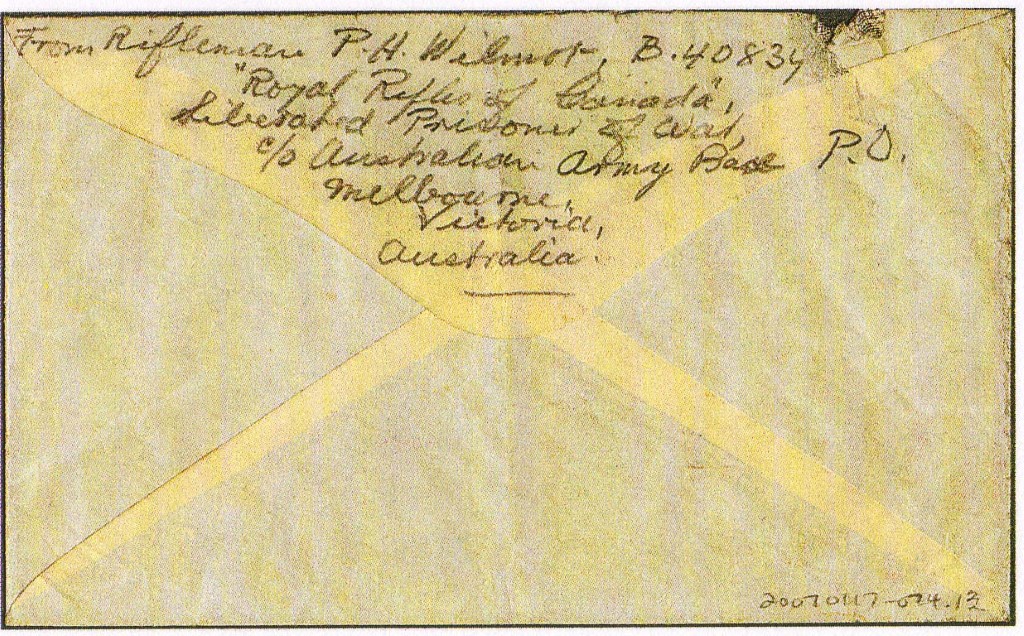
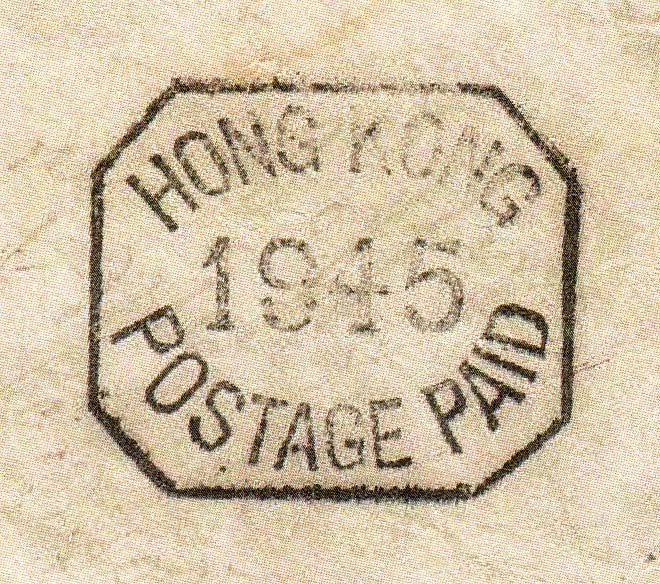
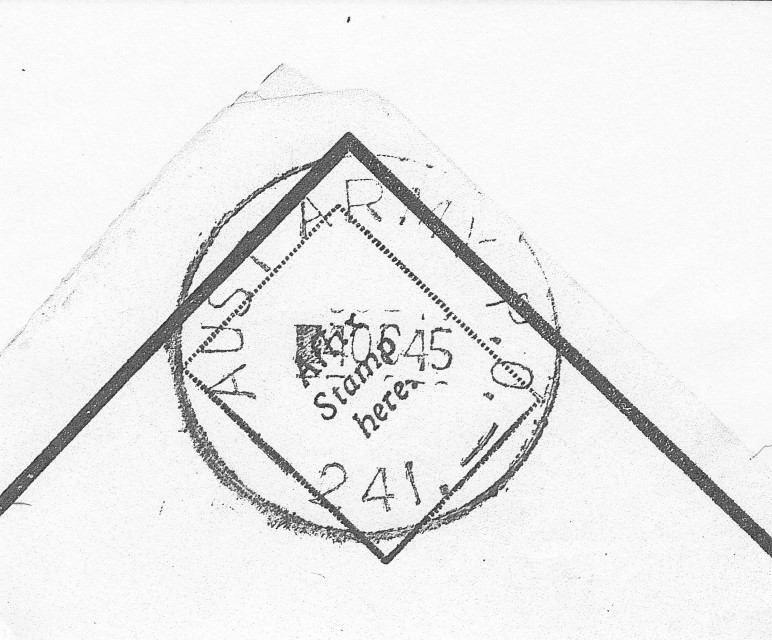
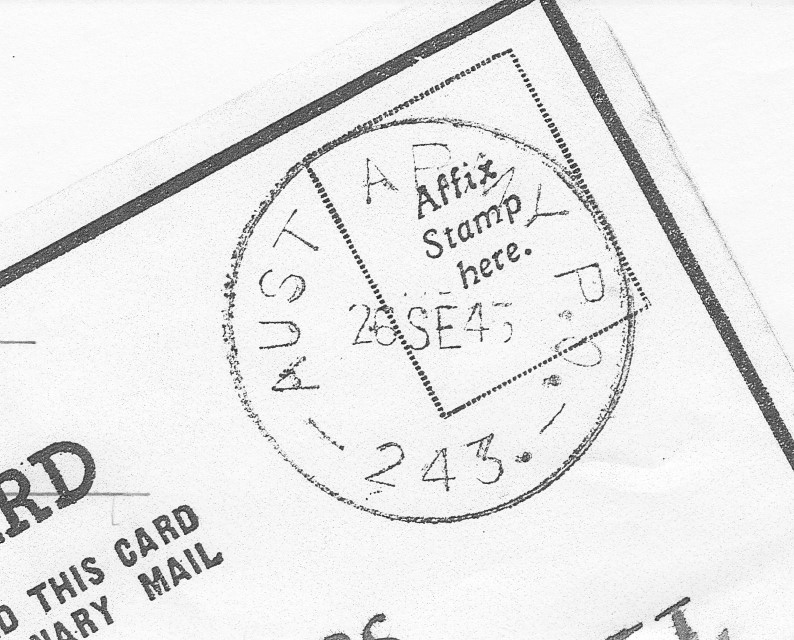
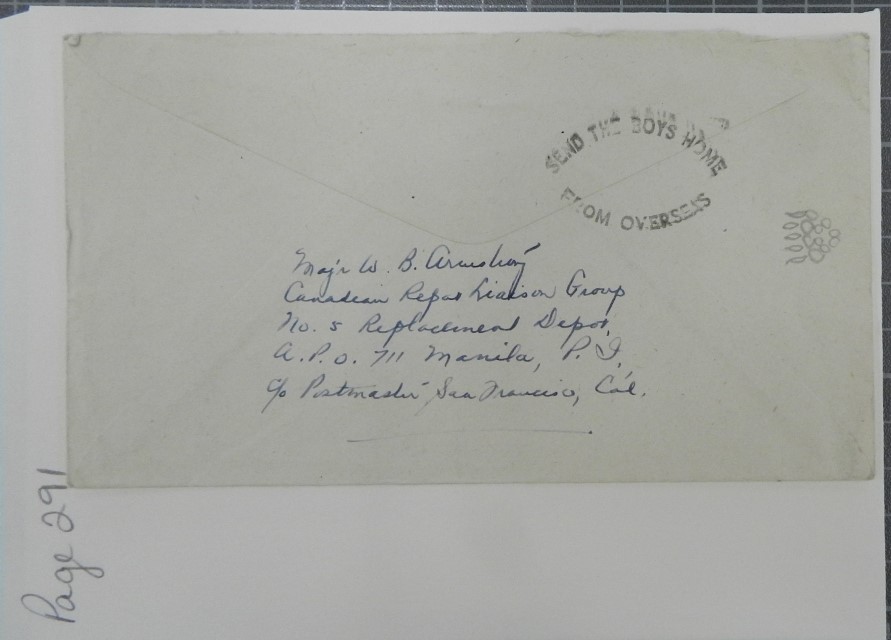

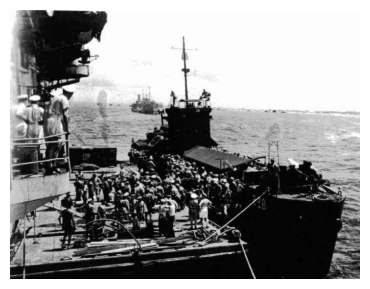

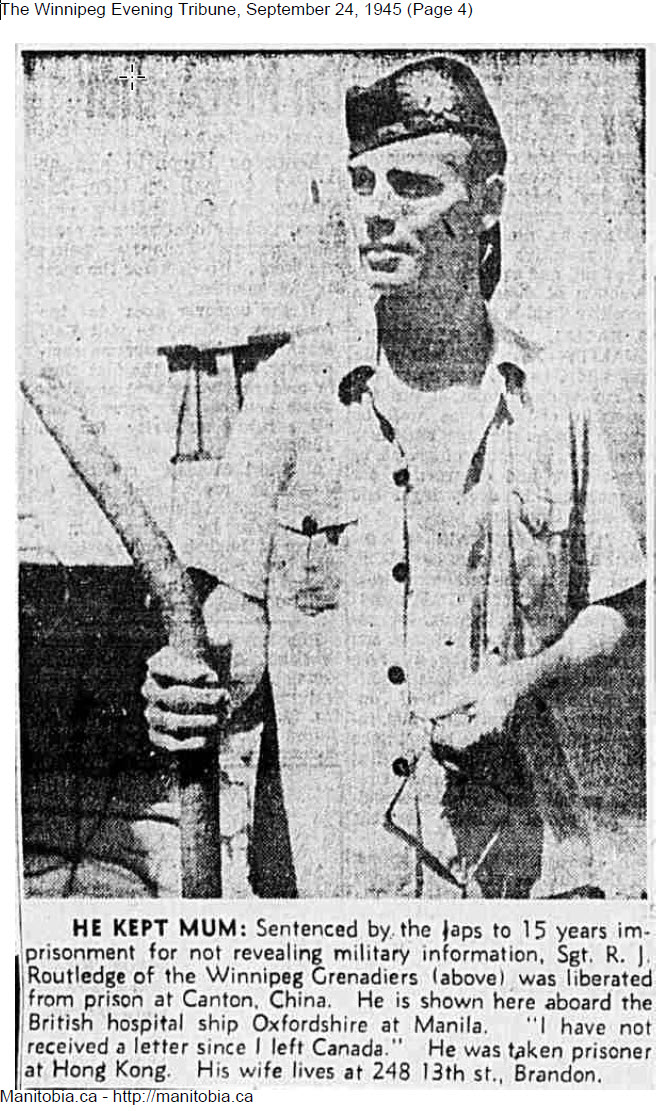
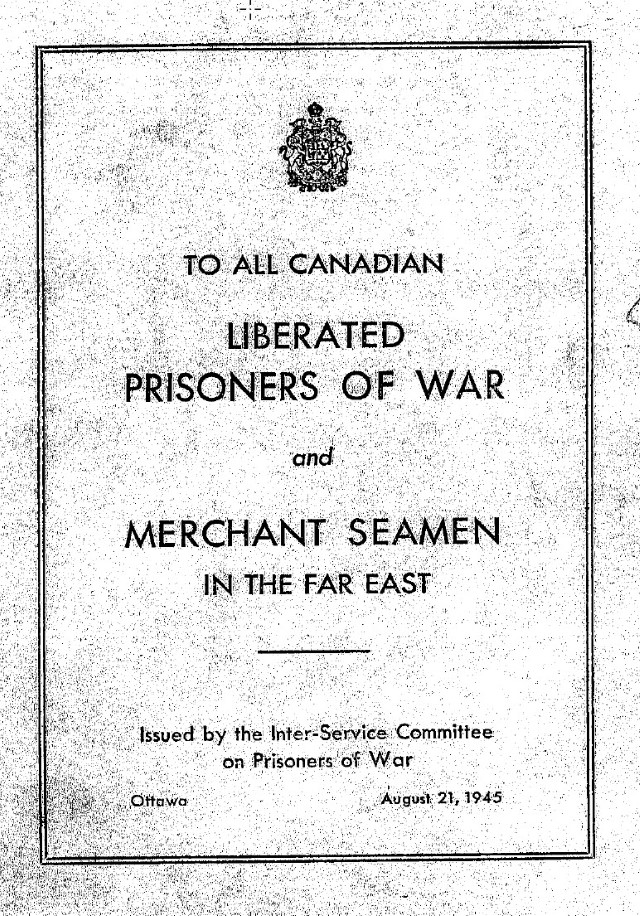
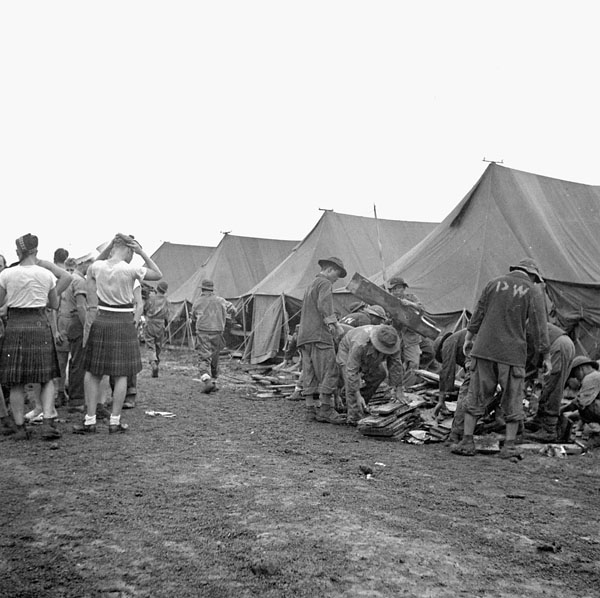
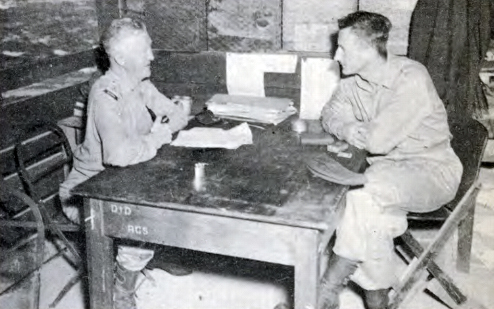
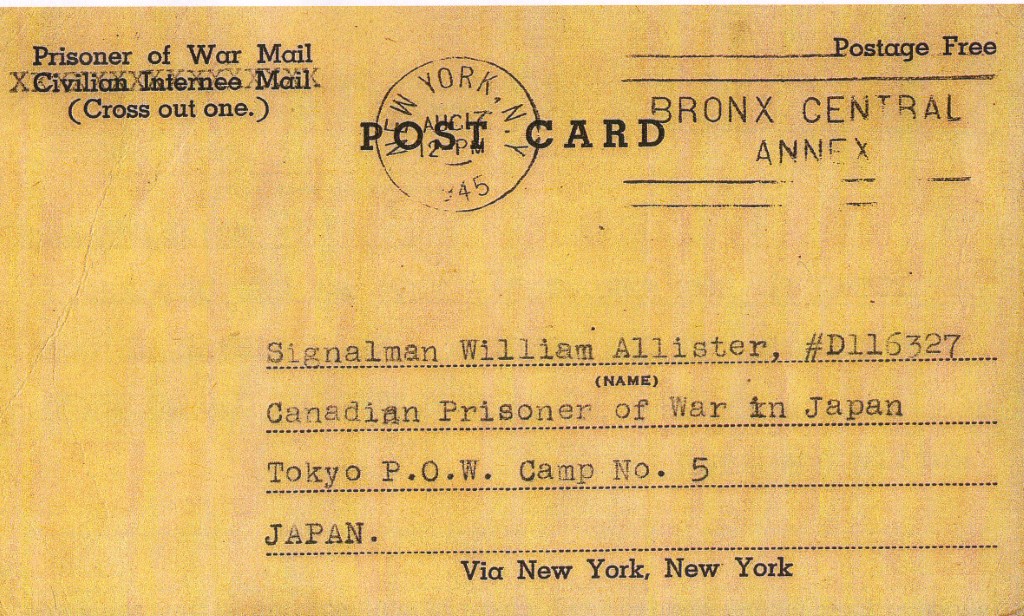

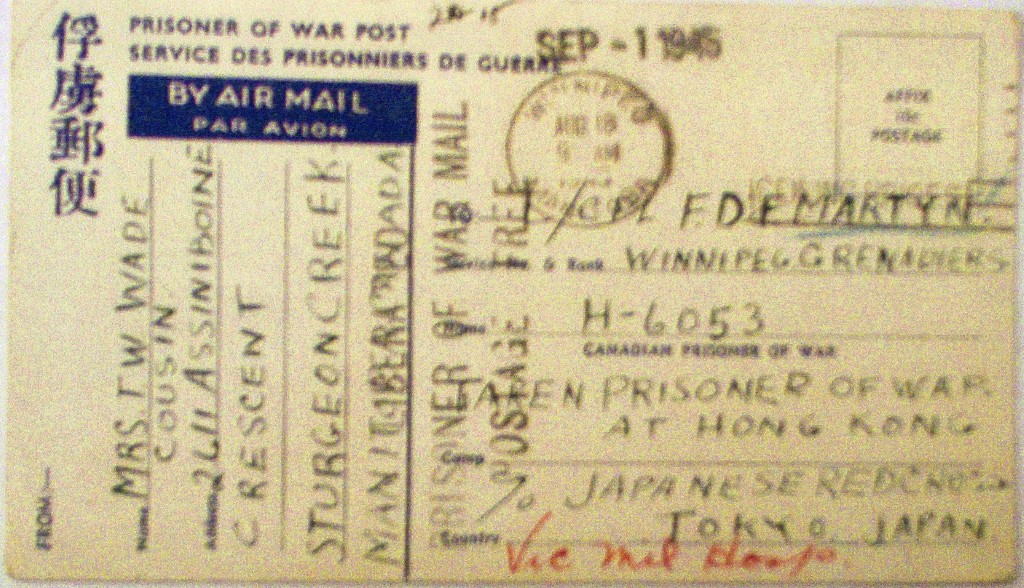
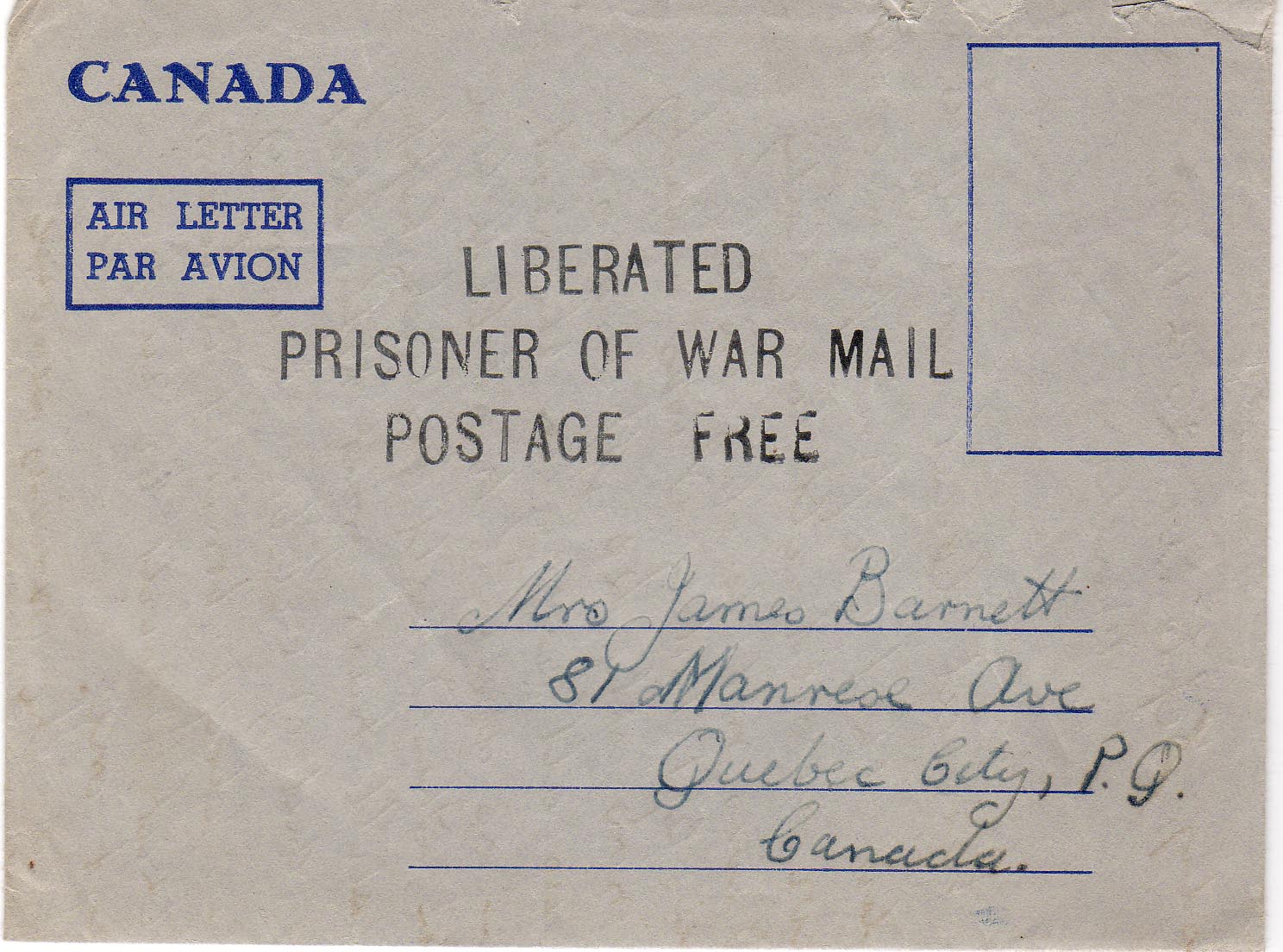

![[Show
cover and inset of hand stamp] Example
of the Type 3, the smaller 3-line serifed rubber handstamp "Liberated
Prisoner / of War Mail / Postage Free”. Click for larger view [Show
cover and inset of hand stamp] Example
of the Type 3, the smaller 3-line serifed rubber handstamp "Liberated
Prisoner / of War Mail / Postage Free”.](images/Figure 60.jpg)
![[Show
cover and inset of hand stamp] Example
of the Type 3, the smaller 3-line serifed rubber handstamp "Liberated
Prisoner / of War Mail / Postage Free”. Click for larger view [Show
cover and inset of hand stamp] Example
of the Type 3, the smaller 3-line serifed rubber handstamp "Liberated
Prisoner / of War Mail / Postage Free”.](images/Figure 60-a.jpg)
